Advance Security TR03 Car Alarm Transceiver User Manual RST871A OP 3KEY
Advance Security Inc Car Alarm Transceiver RST871A OP 3KEY
User Manual
OCT/11/2002
RST871A OP
1
MODEL RST871A
REMOTE ENGINE STARTER
WITH ALARM SYSTEM
OWNER’S MANUAL

OCT/11/2002
RST871A OP
2
TABLE OF CONTENTS:
A. REMOTE TRANSMITTER OPERATION ………………………………………….…………………….………. 4
B. BUTTON LOCK …………………………………………………..……………………………………….……..…. 4
C. LED DISPLAY .……………..………………………………………………………………………….……………. 5
D. CHIRP INDICATOR ..………..…………………………………………………………………………………..…. 5
E. PARKING LIGHT …….……..………………………………………………………………………………..….…. 5
F. ALARM OPERATION CONDITION .…………………………………………………………………………...…. 5
G. ACTIVE ARMING – ARM & LOCK .………………………………………………………………...……………. 5
Defective Sensor Reminder
Silent Arming / Disarming
Shock Sensor By-Pass
H. PASSIVE ARMING .……………………………………………..…………………………………………………. 6
Passive Arming with Passive Door Locking
Passive Arming By-Pass
I. ACTIVE DISARMING – UNLOCK & DISARM .………………………………………………………..…………..6
Tamper Disarming
Pathway Illumination
Two Steps Door Unlock
Automatic Re-Arm
J. DISARMING WITHOUT A TRANSMITTER .……………..…………………………………………………...…. 6
Overrides the Alarm without Password Pin Code
Overrides the Alarm With Password Pin Code
K. VALET MODE .……………..……………………………………………………………………….…………..….. 7
Enter Valet Mode
Exit Valet Mode
L. CAR LOCATOR .……………………………………………………………………….……………………….…... 7
M. PANIC FUNCTION .………………………………………………………………………………..….……….…... 7
N. TRIGGER THE SYSTEM .………………………………………..…………………………..………….………... 8
Clear The Trigger Icons and Melody Sound
Stop The Melody Sound Only
Noise Abatement Circuit
O. ANTI CAR- JACKING .……………………………………………………………………………………………... 8
Active Anti Car Jacking
Passive Anti Car Jacking
Trigger The Anti Car Jacking Mode
Override The System To Turn Off Anti Car Jacking
P. SYSTEM’S TRIGGER CHECK ………………………………………………………………….….….…..….….. 9
Q. SYSTEM’S STATUS CHECK ………………………………………………………………..……….……….….. 9
R. DRIVER PAGING (OPTIONAL) ………..…………………………….…………..……………………...……….. 9
S. DOME LIGHT CONVENIENCE DELAY & SUPERVISION ……………………..………………….……..…….9
T. IGNITION CONTROL THE DOOR LOCK/UNLOCK. ………..………………….…………………………..…..9
U. TRUNK RELEASE (CHANNEL 3) OUTPUT ………..………………………………………………………..…10
V. CHANNEL 4 TIMER CONTROL OUTPUT ………..………………………………………………..…..……….10
W. CHANNEL 5 TIMER CONTROL OUTPUT ………..…………………………………………….….….……... 10
X. CHANNEL 6 TIMER CONTROL OUTPUT ………..…………………………………………….…….…….…. 10
Y. POWER ON MEMONRY: ………..………………………………………………………………….…….…..…. 10
REMOTE START OPERATION:
A. TO REMOTE START THE VEHICLE ………..…………………………………………………………………. 10
Safe Start (Child safety mode)
B. TO OPERATE THE VEHICLE WHILE RUNNING ON THE REMOTE START ………………………..….. 10
C. TEMPORARY STOP FEATURE …………………………..………………….………………………...….…… 11
D. TIMER / TEMPERATURE START …………………………………………….…………….………..………… 11
3 Hours Timer Start With Temperature-Control Off
3 Hours Timer Start With Temperature-Control
Daily Timer Start
Exit the Timer Start

OCT/11/2002
RST871A OP
3
E. TEMPERATURE CHECK …………….………………………………………………….….……….……….… 11
F. TO TURN OFF THE REMOTE START ………………………………………………….….…….…………...…12
G. SHUT-DOWN INPUT FOR REMOTE STARTER ……………………………….………………………..…… 12
H. DISABLING THE REMOTE START SYSTEM ……………………………….……..……………..……..….… 12
LCD REMOTE TRANSMITTER:
A. BATTERY REPLACEMENT ……………………………….…………………………………………………..… 13
B. THE REMOTE LCD ICONS WITH FUNCTION ……….…………………………………………………….… 13
C. PROGRAMMING OF THE LCD REMOTE TRANSMITTER ……………………………………………….… 14
1. Screen Lamp ON
2. Power Save Mode
3. Clear The Flash Icon and Melody Sound
4. Stop The Melody Sound.
5. Button Lock
6. Vibration / Melody Mode
7. Enable / Disable Bi Sound While Pressing Button:
8. Low Battery Indication.
9. Set Up Fixed Count Down Timer
10. Out Of The Range Check
D. TIMER SETTING ……………………………….…………………………..……………………….………….… 15
1. Timer Setting.
2. Alert Alarm Timer Setting
3. Count Down Timer Setting
4. Time Set-Up For “Daily Timer Start”
WARNINGS:
As with any product that performs automatic functions, there are certain safety precautions that you must
practice and be aware of.
1. Keep the transmitter out of children’s reach.
2. Do not leave anyone in the vehicle while running on remote control.
3. Alert servicing personnel that the vehicle can be started automatically.
4. Do not start the vehicle by remote while it’s in an enclosed area or garage.
5. Always apply the parking brake and lock the vehicle as you exit the vehicle.
6. The vehicle windows must be rolled up.
7. Should the unit malfunction, disconnect the fuse until the problem is corrected.
8. The use and operations of this system is the sole responsibility of the operator.
9. Some areas may have local ordinances that prohibit leaving a vehicle running on public streets.
10. Do not start the vehicle by remote while the standard transmission vehicle is parked at a steep place.

OCT/11/2002
RST871A OP
4
OPERATION:
A. REMOTE TRANSMITTER OPERATION:
Transmitter Button System Function Remark
Lock Doors & Arm System
Panic function Press and Hold for 3 seconds.
Car Locator Under armed mode
-
Arm and Delete The 2 Stage Shock Sensor. Press twice within 3 seconds
+ Silent Arming / Disarming Ignition in "off" position.
+ Active Anti Car-Jacking Mode Ignition in "on" position press and
hold for 2 seconds
+ Channel # 4 Timer Output (4)
+ Channel # 5 Timer Output (5)
+ Channel # 6 Timer Output (6)
Unlock Doors & Disarm System
-
Two Steps Door Unlock & Disarm System Press twice within 3 seconds.
Trunk Release (Channel 3) Press and Hold for 2 seconds
-
Passive Arming By-pass While the system Disarmed.
-
( )
Button Lock Press within 3 seconds and Hold
button for 2 seconds
-
Activate or Turn Off The Remote Start Press twice within 3 seconds.
LCD DISPLAY TRANSMITTER OPERATION ONLY:
Transmitter Button System Function Remark
-
(C) System’s Trigger Record Check Press within 3 seconds
-
-
(C)
System’s Status Check Press within 3 seconds
-
( ) Button Lock Press within 3 seconds and Hold
button for 2 seconds
-
( ) Optional Driving Pager Press within 3 seconds
-
( ) Monitor Indoor Temperature Press within 3 seconds
-
( ) Daily Timer Start Press within 3 seconds
LCD screen lamp turns on for 5 seconds. Press and hold for 1 second
- -
Clear the Flash Icon and Melody Sound on
the LCD Screen Transmitter Press within 3 seconds
B. BUTTON LOCK:
It is useful if you want to disable the transmission function of the remote control temporarily to prevent from
any inadvertent pressing of buttons by others.
1. The regular remote control transmitter:
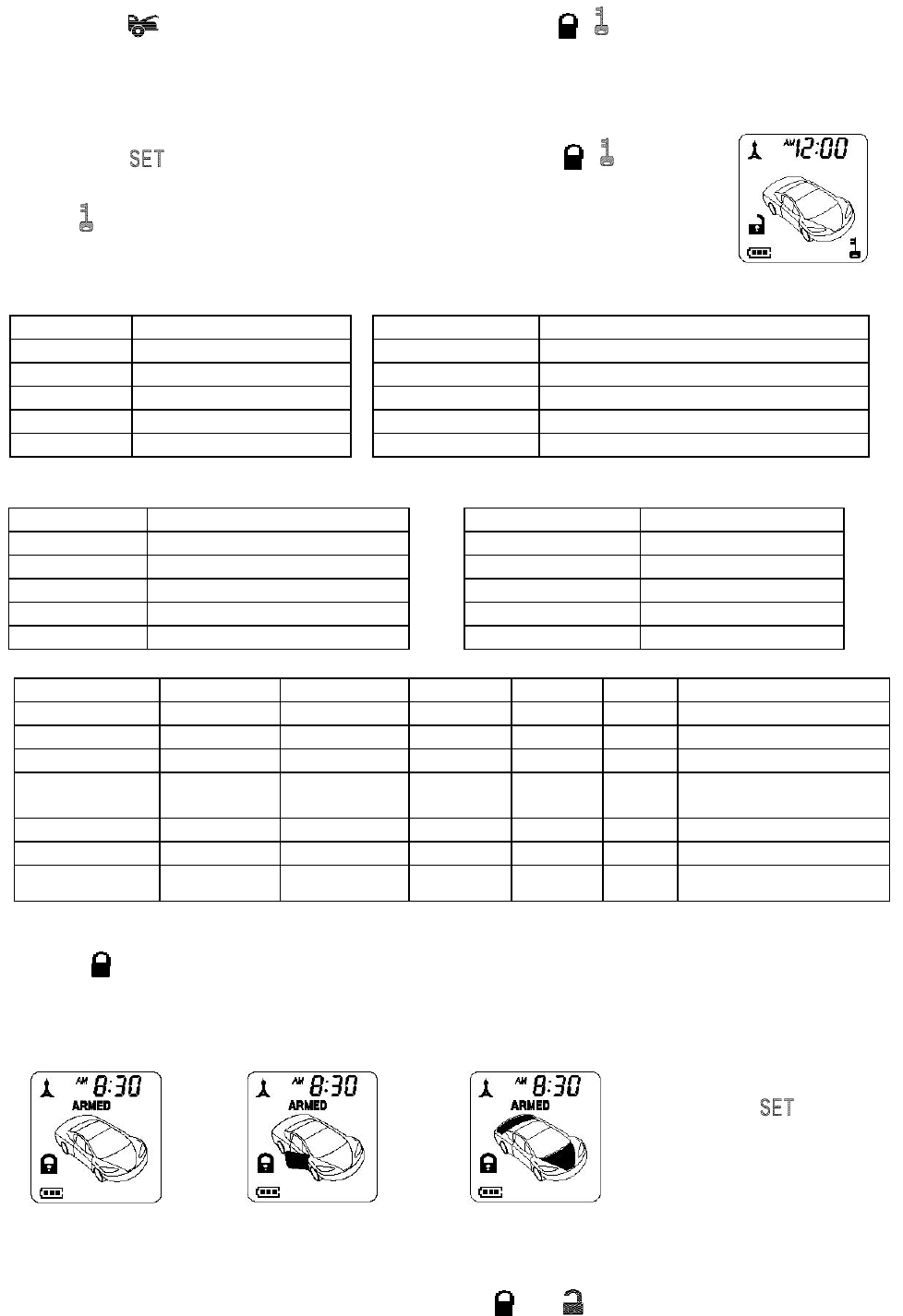
OCT/11/2002
RST871A OP
5
Press the button first, within 3 seconds press and hold the () button for 2 seconds to activate or
cancel the button lock function. The “Red LED” will pause flash for few seconds to indicate the remote
control transmitter is on “Button Lock” mode while press the transmitter button.
2. The 2-way remote control transmitter:
Press the button first, within 3 seconds press and hold the ()
button for 2
seconds to activate or cancel the button lock function.
The icon will displayed on the LCD screen to show the LCD remote transmitter
is on “Button Lock”.
C. LED display:
LED Function LED Function
Off Disarmed Zone 1 / Warn-Away Trigger
Slow Flash Armed 2 flashes... pause Zone 2 / Trigger on Trunk/Hood
Flash Passive Starter Disable 3 flashes... pause Zone 3 / Trigger on Door Switch
Fast Flash Passive Arming 4 flashes... pause Zone 4 / Trigger on Shock Sensor
On (Solid) Valet Mode
5 flashes... pause Zone 5 / Trigger on Ignition Switch
D. CHIRP INDICATORS: E. PARKING LIGHT:
Chirp Function Parking light Function
1 chirp Arm 1 flash Arm
2 chirps Disarm 2 flashes Disarm
3 chirps Defective Reminder 3 flashes Disarm / Triggered
4 chirps Disarm / Triggered 12 flashes Car Locator
6 chirps Car Locator Constant On Under Remote Start
F. ALARM OPERATING CONDITION:
Siren / Horn Parking Light LED Doors Starter Dome Light
1. Arming 1 or 3 Chirps 1 Flash Slow Flash Locking Disable
2. Disarming 2 or 4 Chirps 2 or 3 Flashes Unlocking Turns on for 30 -second
3. Trigger Alarming Flashes Slow Flash Disable
Flashes
4. Passive
Starter Disable
Fast Flash Disable
5. Panic Alarming Flashes Flashes
6. Car-Jacking Alarming Flashes Disable
Flashes
7. Car Locator 6 Chirps 12 Flashes Locking
G. ACTIVE ARMING – LOCK & ARM:
1.Press button on the transmitter.
2.The siren will chirp once and parking light will flash once indicating that the system is now armed. The
vehicle door will lock upon arming when interfaced with the security system.
System Arm
Door Ajar
Trunk / Hood Ajar
Clear The Flash Icon:
Press the button 3
times within 3 seconds
will clear the flash icon on
the LCD screen
transmitter.
DEFECTIVE SENSOR REMINDER: If the siren sounds 3 chirps, then you have left a door, trunk, or hood
lid ajar. (See Alarm Feature “I - 4 Programming)
SILENT ARMING / DISARMING: Press the transmitter and button at the same time will arm or
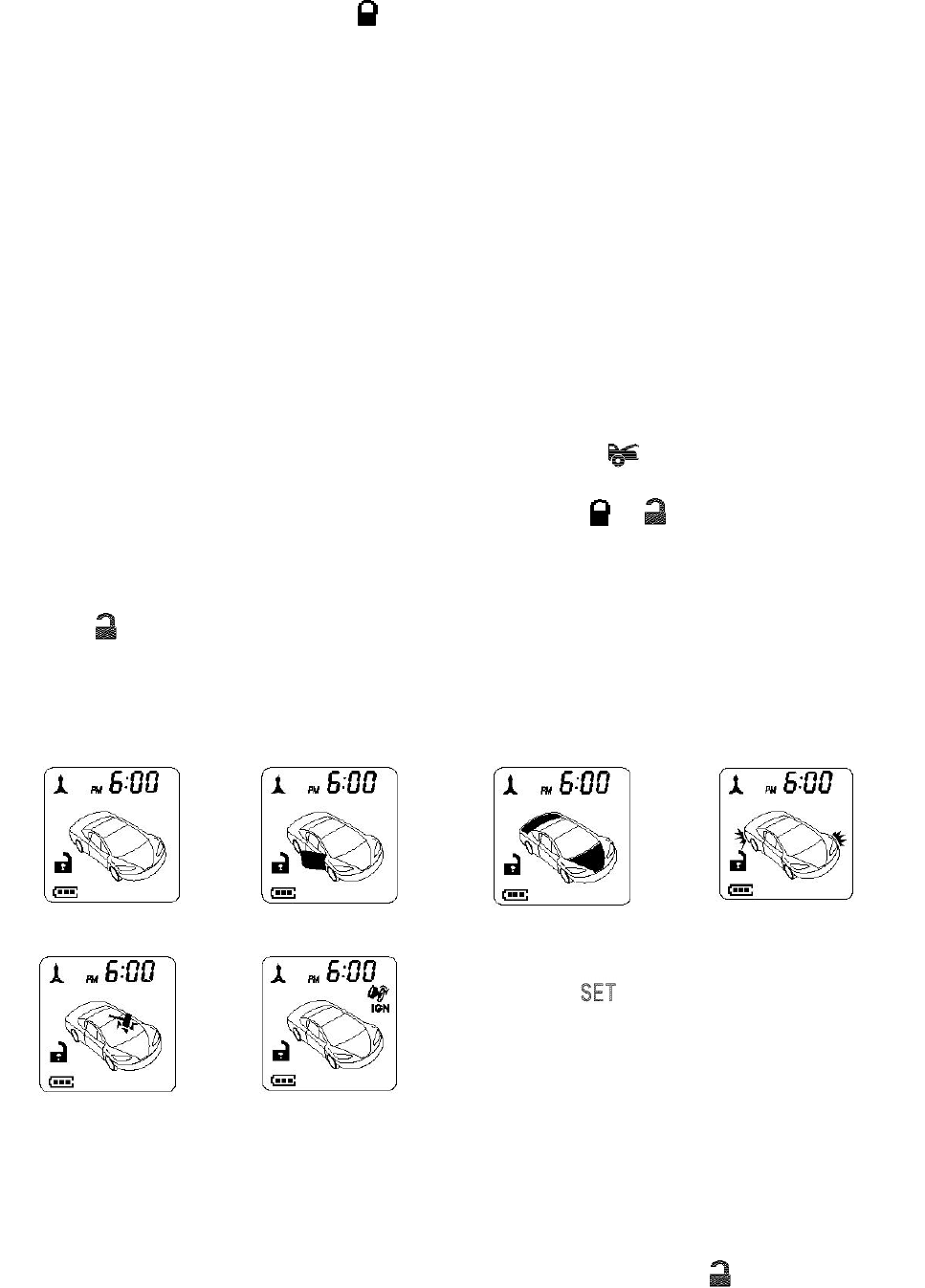
OCT/11/2002
RST871A OP
6
disarm your security system, No chirp sound will be heard, arm / disarm confirmation will be through the
vehicles parking lights only.
SHOCK SENSOR BY-PASS: Press the button on the transmitter two times within 3 seconds will arm the
security system and by-pass the shock sensor. The system will chirp one additional time to confirm the
sensor bypass mode was activated. The sensor bypass feature is programmed to activate for one arming
cycle only. The security system will return to normal operation during the next arming cycle.
H. PASSIVE ARMING
Active arming / disarming is controlling your security system via the remote transmitter. This security system
is equipped with an optional Passive Arming feature, which allows the security system to arm 30 seconds
after the last door is closed. Operation is as follows.
1. Turn the ignition to the “OFF” position and exit the vehicle.
2. After all entrances are closed, the security system LED will flash fast for 30 seconds. If you reopen any
door / hood / trunk, the security system LED will stop flashing. It will begin flashing again once the vehicle
all entrances are closed.
3. After 30-second timer has elapsed, the security system will automatically “ARM”. The siren will chirp [1]
time and the parking lights will flash [1] time.
PASSIVE ARMING WITH PASSIVE DOOR LOCKING (See Alarm Feature “I - 2” Programming):
The vehicle doors will automatically lock after passive arming cycle has been completed.
PASSIVE ARMING BY-PASS: While the system disarmed, Press the buttons twice, the security will
respond with [1] chirp and LED will turn “ON”. The security system will remain in this temporally state for as
long as you wish. To exit passive by-pass, press the transmitter or button and the system will
return to normal status.
I. ACTIVE DISARMING – UNLOCK & DISARM:
1. Press button on the transmitter.
2. The siren will chirp twice and parking light flash twice to indicating that the security system is now
disarmed. The vehicle’s door will unlock and dome light turns on for 30 seconds upon disarming when
interfaced with the security system.
System Disarm
Doors Trigger
Trunk/Hood Trigger
Warn away Trigger
Shock Sensor Trigger
Ignition Trigger
Clear The Flash Icon:
Press the
button 3
times within 3 seconds will
clear the flash icon on the
LCD screen transmitter.
TAMPER DISARMING: If alarm triggered, upon disarm the system, siren chirp 4 times, parking light flash 3
times.
PATHWAY ILLUMINATION (See Alarm Feature “II - 3” Programming): This feature turns the parking light
“ON” for 30 seconds upon a unlock signal and for 10 seconds upon the lock signal.
TWO STEPS DOOR UNLOCK (See Alarm Feature “III - 2” Programming): This feature will independently
unlock the driver’s door only when disarming the security system. Pushing the button a second time
within 3 seconds will unlock the other doors.

OCT/11/2002
RST871A OP
7
AUTOMATIC RE-ARM (See Alarm Feature “I - 3” Programming): If this feature is selected, the security
system will automatically re-arm itself in 60 seconds after disarming with remote transmitter. Automatic
rearm will cancel if any door is opened before the 60 seconds timer has elapsed.
J. DISARMING WITHOUT A TRANSMITTER ( Alarm Feature III - 1 Programming )
OVERRIDES THE ALARM WITHOUT PASSWORD PIN CODE: (Factory Default Setting)
The Override function may be used if the remote transmitter is lost or inoperative.
1. Enter the vehicle and turn the ignition switch to 'ON’ position. (Alarm will sound.)
2. Within 10 seconds push and release the valet switch
The alarm will stop sounding and enter the disarm mode. You can now start and operate the vehicle
normally.
OVERRIDE THE ALARM WITH PASSWORD PIN CODE: (Alarm Feature III - 1 Programming)
Unlike valet switch easily found, and defeated, this security system allows the consumer to program a
password pin code. Offering a higher level of security.
1. Enter the vehicle and turn the ignition switch to 'ON’ position. (Alarm will sound.)
2. Within 5 seconds, enter your chosen the first digit code by press and release the Valet Switch.
(When finished above procedures, system's siren stop alarming, parking light stop flashing, but the
vehicle can not be start and drive away.)
3.Within 15 seconds of the last digit code enter (the 1st code), turn the Ignition Switch “OFF” and then
“ON”.
4.Within 15 seconds, enter your chosen of the second digit code by press and release the Valet Switch.
5.Turn the ignition switch “OFF” position.
[4] Chirps form siren/horn, [3] flash from parking light to indicate the system was disarmed.
Note 1: You must override the alarm within 60 seconds. If not, the system will automatically re-arm.
EXAMPLE: To Override The System With The Password Code 83, you would;
1. Enter the vehicle and turn the ignition switch to 'ON’ position. (Alarm will sound.)
2. Within 5 seconds, Press and Release the Valet Switch 8 times
(When finished above procedures, system's siren stops alarming, parking light stop flashing, other
sensor stop trigger, but the vehicle can not be start and drive away.)
3. Within 15 seconds of the last digit code enter (the 1st code), turn the Ignition Switch “Off” and then “ON”.
4. Within 15 seconds, Press and Release the Valet Switch 3 times
5. Turn the Ignition Switch to “Off” position.
[4] Chirps form siren/horn, [3] flash from parking light to indicate the system was disarmed.
K. VALET MODE: (System in Disarm or Valet mode)
The valet switch allows you to temporarily bypass all alarm function, eliminating the need to hand your
transmitter to parking attendants or garage mechanics. When the system is in valet mode, all alarm function
and remote start function are bypassed, however the remote panic feature and remote door locks will remain
operational. To use the valet mode, the system must first be disarmed either by using you remote
transmitter, or by operating the Manual override sequence.
Enter Valet Mode:
1.
From the disarmed condition, turn the ignition to
“ON” position.
2.
Push and hold valet switch for 2 seconds until the
LED tu
rns on. The LED wills remain on as long as
the system is in 'valet mode'.
Remote Door Lock
Remote Door Unlock
Exit Valet Mode:
1. Return to normal operation, turn ignition 'on'.
2. Push and hold valet switch for 2 seconds, The LED wills turns off indicate the system are exiting the
valet mode.
L. CAR LOCATOR
Under armed mode, press the button to active car locator function. The siren will chirp 6 times. The
parking light will flash 12 times, for you to easily locate your car.
M. PANIC FUNCTION: (See Alarm Feature I - 7 Programming.)
The transmitter can be used as a remote panic switch to manually trigger the alarm in case emergency.
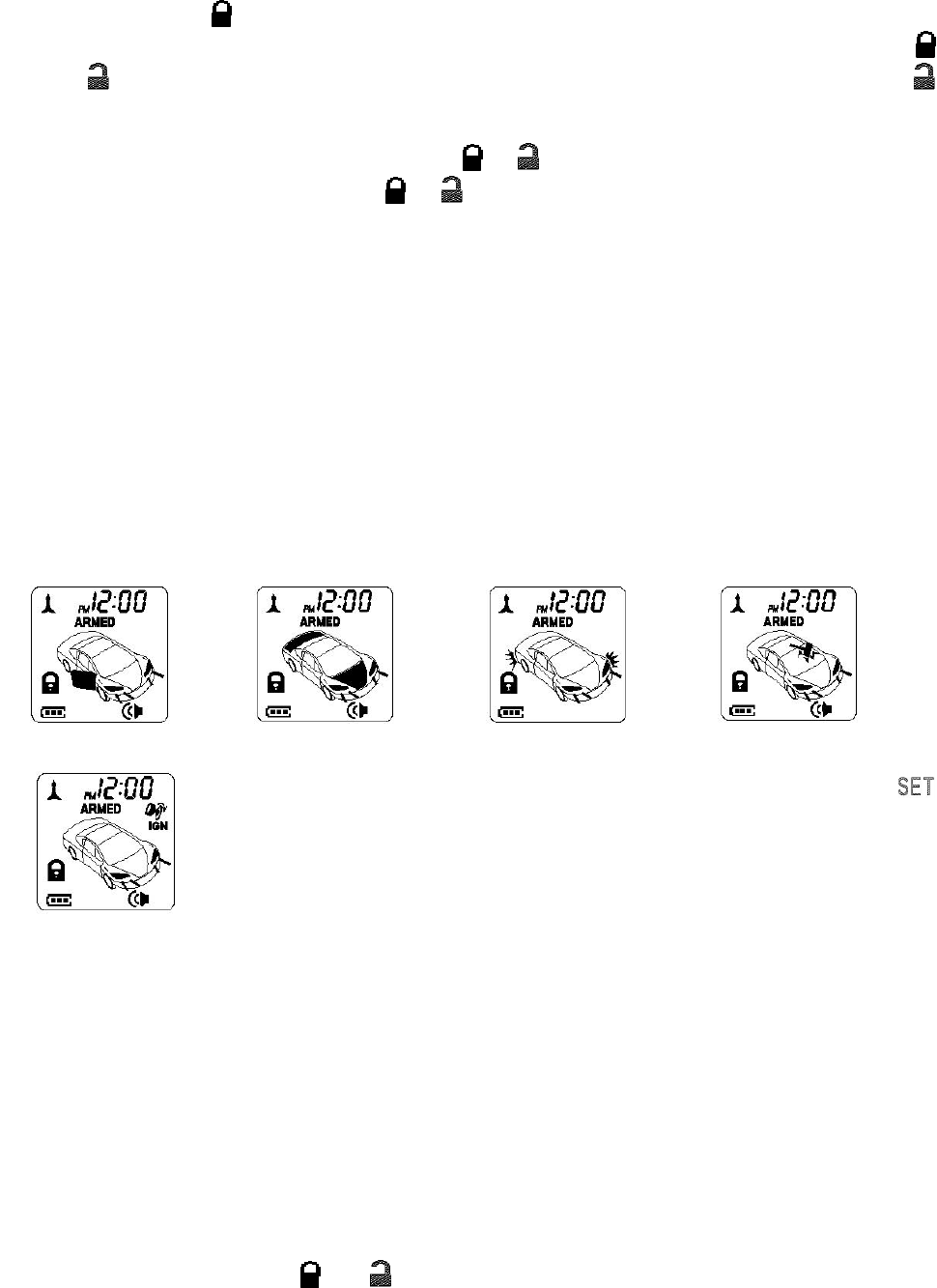
OCT/11/2002
RST871A OP
8
1. Press and hold the button for 3 second. The alarm will immediately sound.
2. During panic mode, the normal function of this transmitter button will be suspended. The transmitter
and buttons can be used to lock and unlock the door (if the option is installed), however once the
button is pressed, the vehicle’s starter disable device, (where installed) will be enable allowing the vehicle
to start.
3. To stop the alarm, press and hold the transmitter or button on the transmitter again for 3 seconds.
Also if any transmitter button other than or button is pressed and released, the panic mode will be
turned off immediately.
4. If the button is not pressed, the alarm will automatically stop after 60 seconds.
N. TRIGGER THE SYSTEM
When armed, your vehicle is protected as follows:
1.Light impact will trigger the warn-away signal.
2.Heavy impacts / Doors open / Hood open / Trunk open / Turn on the ignition key will trigger the
programmed sequence.
The starter disable relay (if installed) prevents the vehicle’s starter from cranking. The siren, horn, parking
lights, and dome light will turn on to alerting of an intrusion for 60 seconds. Then it will stop and automatic
reset and re-arm. If the one of sensors or detectors still active, the alarm system will sound a maximum of 3
times of 60 seconds cycles.
Doors Trigger
Trunk/Hood Trigger
Warn-away Trigger
Shock Sensor Trigger
Ignition Trigger
CLEAR THE FLASH ICON AND MELODY SOUND:
While triggering the alarm the LCD
screen will alert user through melody sound and flashing trigger icon, press the
button 3 times within 3 seconds will clear the flash icon and stop melody sound on the
LCD screen transmitter.
STOP THE MELODY SOUND ONLY: While triggering the alarm the LCD sc
reen will
alert user through melody sound and flashing trigger icon, press any button on the LCD
remote transmitter to stop melody sound only
NOISE ABATEMENT CIRCUIT: You system has “Noise Abatement Circuit”. It prevents annoying repetitive
trigger sequences due to faulty door pin switches or environmental condition such as thunder, jackhammers
airport noise, etc.
Here’s how “Noise Abatement Circuit” works: The alarm triggers five times. Each time, the same sensor or
switch is triggering the alarm. “Noise Abatement Circuit” will interpret this pattern of triggers as false alarm.
After the fifth trigger, “Noise Abatement Circuit” ignores, or bypasses, that sensor or switch until the other
sensor or switch is trigger.
“Noise Abatement Circuit” covers doors (Hood/Trunk) differently: If the alarm is triggered by an open door for
three full cycles, the doors will be bypassed until the trigger ceases.
O. ANTI CAR- JACKING
Warning: If you don't need the car jacking function in this alarm system, be sure to set car jacking feature
“OFF”. This system is default setting all car-jacking “OFF”. (See Alarm Feature I - 6 Programming.)
ACTIVE ANTI CAR JACKING:
1.Press and hold the transmitter and button at the same time for 2 seconds while the vehicle’s
ignition is ON. The parking lights will turns on for 1.5 seconds to indicate this enter.
2.Once the system is armed, If you are forced from the vehicle, the system will trigger when the door is
opened and closed while the ignition is “ON”.
PASSIVE ANTI CAR- JACKING:
It operate as below:
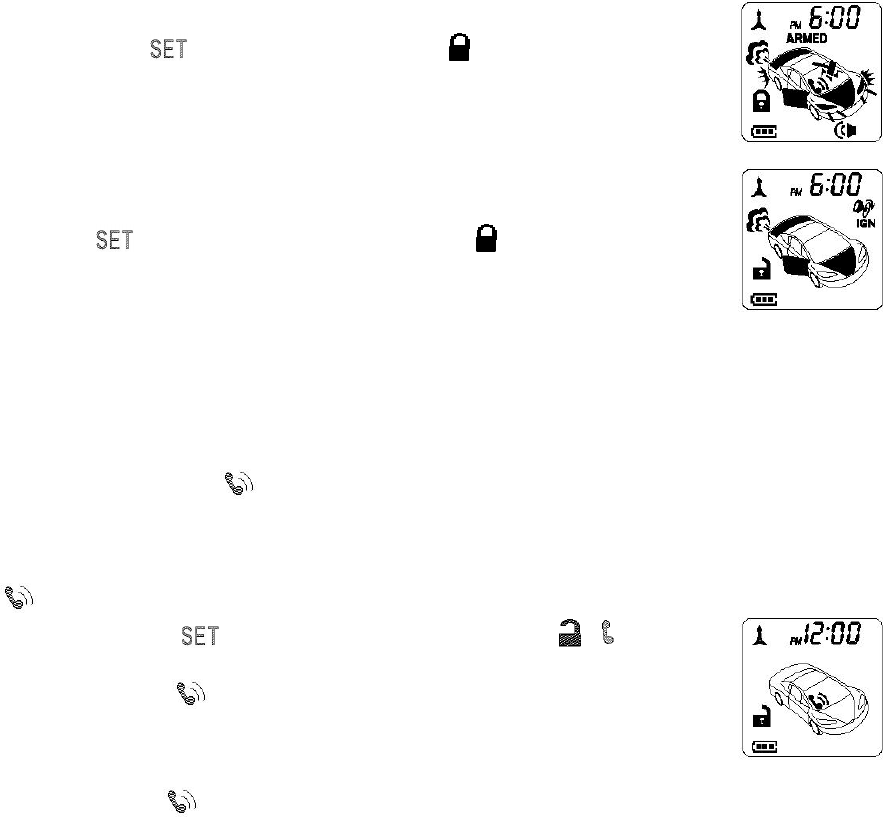
OCT/11/2002
RST871A OP
9
1.Turn the ignition switch to “ON” position, the system will arm.
2.Once the system is armed, If you are forced from the vehicle, the system will trigger when the door is
opened and closed while the ignition is “ON”.
TRIGGER THE ANTI CAR -JACKING MODE:
3-timer circuits will function as follows:
First timer:
a. 50 seconds after the system has been triggered. The siren will start chirping for 15 seconds.
b. During this 15 seconds period of chirping, you will be alerting to push the valet switch once to turn off
the car-jacking feature.
c. If not, it will enter second timer car jacking.
Second timer:
65 seconds after the system has been triggered. The siren starts alarming and the parking light starts
flashing.
Third timer:
90 seconds after the system has been triggered
a. The siren still alarming and the parking light flashing, and
b. The starter disable will activate to prevent the vehicle from starting.
c. It will remain active until the vehicle's battery power exhausted.
OVERRIDE THE SYSTEM TO TURN OFF ANTI CAR- JACKING:
Turn the ignition switch from OFF to ON, and within 10 seconds push valet switch, the siren will stop and the
system disarmed
Note: If you use password pin code to double protect the vehicle security, you will need to use it to
completely disarm the system.
P. SYSTEM’S TRIGGER CHECK
Press the transmitter first, within 3 seconds press (C) button. It responds
with one melody sound and all trigger’s records will immediately displayed on the LCD
screen.
Q. SYSTEM’S STATUS CHECK
When you want to check the system’s present status through the LCD screen, Press
the transmitter button twice, within 3 seconds press (C) button. It responds
with one melody sound, the LCD screen should be illuminated.
R. DRIVER PAGING
It is useful the event that someone wants to page the driver of the parked vehicle.
Indoor Driving Paging
Under the ignition switch “off” condition, press and hold the valet switch for 2 seconds to page the driver, one
chirp sound shall be emitted from the vehicle and the paging melody sound continues sounding from you
Remote LCD Transmitter and “ ” indication flashes on the LCD screen.
Outdoor Driving Paging
If someone tries to page you by tapping the paging (knock) sensor (optional) which is usually mounted on the
bottom part of front window, the paging melody sound continues sounding from you Remote LCD Transmitter
and “ ” indication flashes on the LCD screen.
1. Press the transmitter button first, within 3 seconds press () button
to
activate outdoor driver paging function
, It responds with chirps of the vehicle, a
melody sound and "
" indication flashes on the LCD screen to confirm the
function is on.
2. When tapping the paging (knock) sensor, one chirp sound shall be emitted from
the vehicle and the paging melody sound continues sounding from you Remote
LCD Transmitter and “ ” indication flashes on the LCD screen.
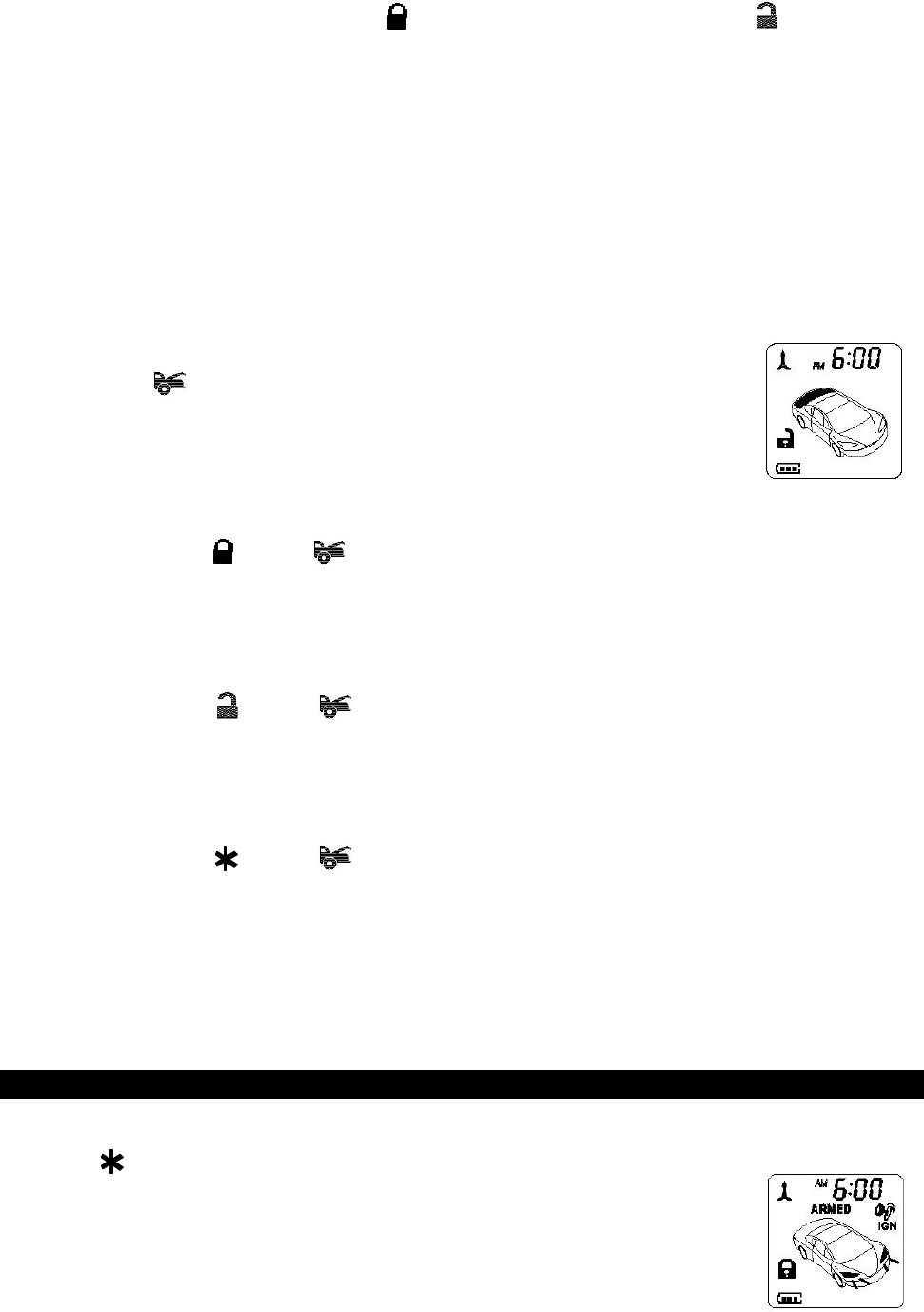
OCT/11/2002
RST871A OP 10
3. Turn on the ignition switch; OR press the button to arm the system; OR press the button to
disarm the system, this outdoor driver paging function will exit.
S. DOME LIGHT CONVENIENCE DELAY & SUPERVISION
The alarm with a unique feature which will turn on your vehicle dome light as following:
1.Upon disarming, the interior light will remain on for 30 seconds.
2.If the vehicle is intruded, the interior light will flash for the same duration as the siren.
Note: Turn on the ignition switch or arm the alarm will turn off the dome light.
T. IGNITION CONTROL DOOR LOCK/UNLOCK. (See Alarm Feature II – 2 Programming).
If the vehicles door locks have been interfaced to the security system, the system will automatically lock the
vehicle's doors when the ignition is turned “ON” and /or unlock the vehicle’s doors when the ignition is turned
“OFF”.
U. TRUNK RELEASE (CHANNEL 3) OUTPUT.
Press and hold button on the transmitter for two seconds to remote control the
trunk release or other electric devices.
V. CHANNEL 4 TIMER CONTROL OUTPUT (See Alarm Feature III – 5 Programming.)
Press the transmitter (4) and (4) button at the same time to active Channel 4 function. Channel 4
is user-programmable timer output. You may program the built-in timer to send a ground signal for any time
duration from 1 second to 120 seconds. For instance, this timer output may be used to turn on the headlight,
power window or sunroof. (Factory defaults setting at momentary output.)
W. CHANNEL 5 TIMER CONTROL OUTPUT (See Alarm Feature III – 6 Programming.)
Press the transmitter (5) and (5) buttons at the same time to active Channel 5 function. Channel
5 is user-programmable timer output. You may program the built-in timer to send a ground signal for any
time duration from 1 second to 120 seconds. For instance, this timer output may be used to turn on the
headlight, power window or sunroof. (Factory defaults setting at momentary output.)
X. CHANNEL 6 TIMER CONTROL OUTPUT (See Alarm Feature III – 7 Programming.)
Press the transmitter (6) and (6) buttons at the same time to active Channel 6 function. Channel
6 is user-programmable timer output. You may program the built-in timer to send a ground signal for any
time duration from 1 second to 120 seconds. For instance, this timer output may be used to turn on the
headlight, power window or sunroof. (Factory defaults setting at momentary output.)
Y. POWER ON MEMONRY:
This security system is equipped with circuitry that will allow the unit to remember its alarm state if the power
is lost and then reconnected.
REMOTE START OPERATION:
A. TO REMOTE START THE VEHICLE:
When you want to start your vehicle,
1. Press button twice on the transmitter.
2. The parking light will activate to indicate the remote start received the signal.
3. The engine will start approximately 5 seconds.
4. Once the engine is running, after couple seconds the parking light will turn on again
and climate controls will activate and adjust the vehicles interior temperature to your
preset setting.
5. The vehicle will run for 5 to 30 minute cycle and automatically shut down.
NOTE: The Remote Start Unit will not start the vehicle if any one of the following
conditions exists:
1. The hood is opened.
Activate Remote
Start
Engine Running
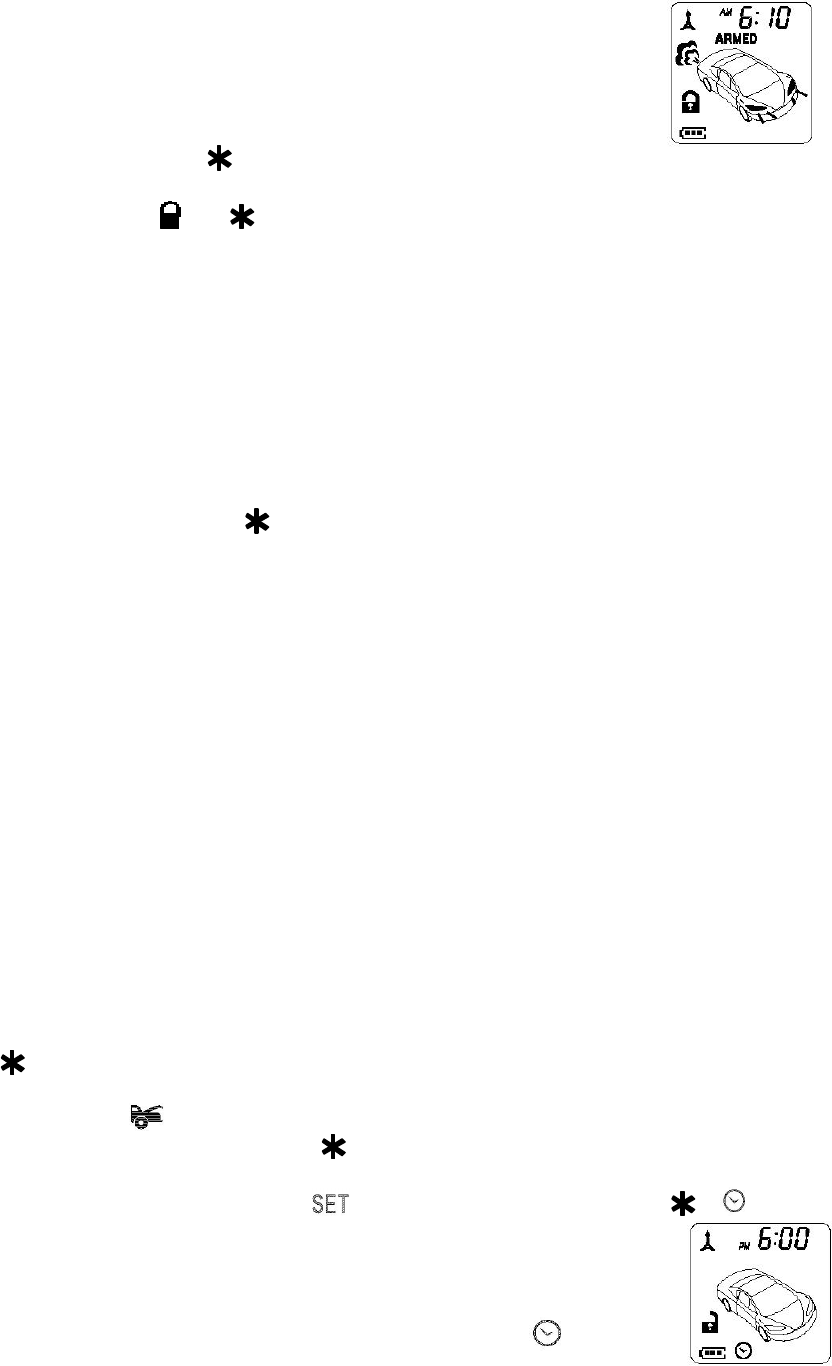
OCT/11/2002
RST871A OP 11
2. The brake pedal is pressed.
3. Move the optional remote start enable toggle switch to OFF position. (If installed)
4. The gear selector is in any gear other then “PARK” or “NEUTRAL”
SAFE START (Child safety mode) (See Start Feature I – 5 Programming.)
Factory defaults setting to press the button twice on the transmitter to start the vehicle. Programming
this feature to eliminate an accidental remote start, when kids enter this transmitter, it requires:
The user press the transmitter and buttons at the same time to start the vehicle.
B. TO OPERATE THE VEHICLE WHILE RUNNING ON THE REMOTE START:
To operate the vehicle while engine running on the remote start.
1. Insert the ignition key and turn it to “ON” (not the start) position.
2. Press the brake pedal.
Note: If the brake pedal is pressed before the key is in the ON position, the engine will shut down.
C. TEMPORARY STOP FEATURE:
This feature allows the vehicle to remain running after the key has been removed from the ignition. This
feature is useful for occasions when you wish to exit and lock the vehicle for short periods of time, but would
like to leave the motor running and the climate control on.
1.Before turning off the engine, press the button twice on the transmitter and the LED indicator will flash
3 times to confirm enter.
2.Turn the ignition key to OFF position. (The engine will stay running.)
3.The engine will run until the pre-programmed time elapsed or shutdown input is received.
D. TIMER / TEMPERATURE START:
This unit can be programmed to start and run the engine every 3 hours or punctually at the same time next
morning, The engine will run for the programmed running time and then shut down.
IMPORTANT: Timer Start should be used only in open areas, Never start and run the vehicle in on enclosed
space as a garage or carport.
3 hours timer start with Temperature-control OFF: This feature is design for an extreme cold climate
usage. The system will auto start the vehicle every 3 hours, to prevent engine freezing and hard to start.
A MAXIMUM OF SIX CYCLES CAN OCCUR.
3 hours timer start with Temperature-control: (See Start Feature I – 7 Programming.)
If you installed the optional Temperature Sensor and programmed the temperature ON to operate. The
system can be programmed to automatically start the vehicle engine whenever the temperature inside the
vehicle reaches or drops below the preprogrammed temperature level. The system will monitor the air
temperature every 3 hour and will only start the engine during extreme cold temperatures. There are three
temperature level to choose form.
Daily Timer Start: The feature is very useful for the driver who wants to run the vehicle punctually at the
same time next morning. Before set-up of the “Daily Timer Start”, you should set you time for engine
start.( see Timer Setting / Timer set-up for “Daily Timer Start, page 16)
ENTER:
1. Press the button twice to remote start the vehicle. As soon as the vehicle is running and the parking
light have turned on or flashing.
2. Immediately depress the button once, within 2 seconds
3-a. 3 Hours Timer Start: Rapidly depresses the button. The parking light will flash (3) times. The
siren or horn chirps (3) times. The vehicle is now programmed to start every (3) hours.
3-b. Daily Timer Start: Depress the transmitter button first, within 3 seconds press ()
button. The parking light will flash (6) times. The siren chirps (6)
times. The vehicle is now programmed to start at the real time of
the next day.
Your set time for the next day engine start flashes for approx. 3
seconds on the LCD screen. After 3 seconds the
icon stays
displayed on the LCD screen.
4. Press the brake pedal to stop the vehicle running.
Exit the timer start:
Timer start can be exited manually as follows:
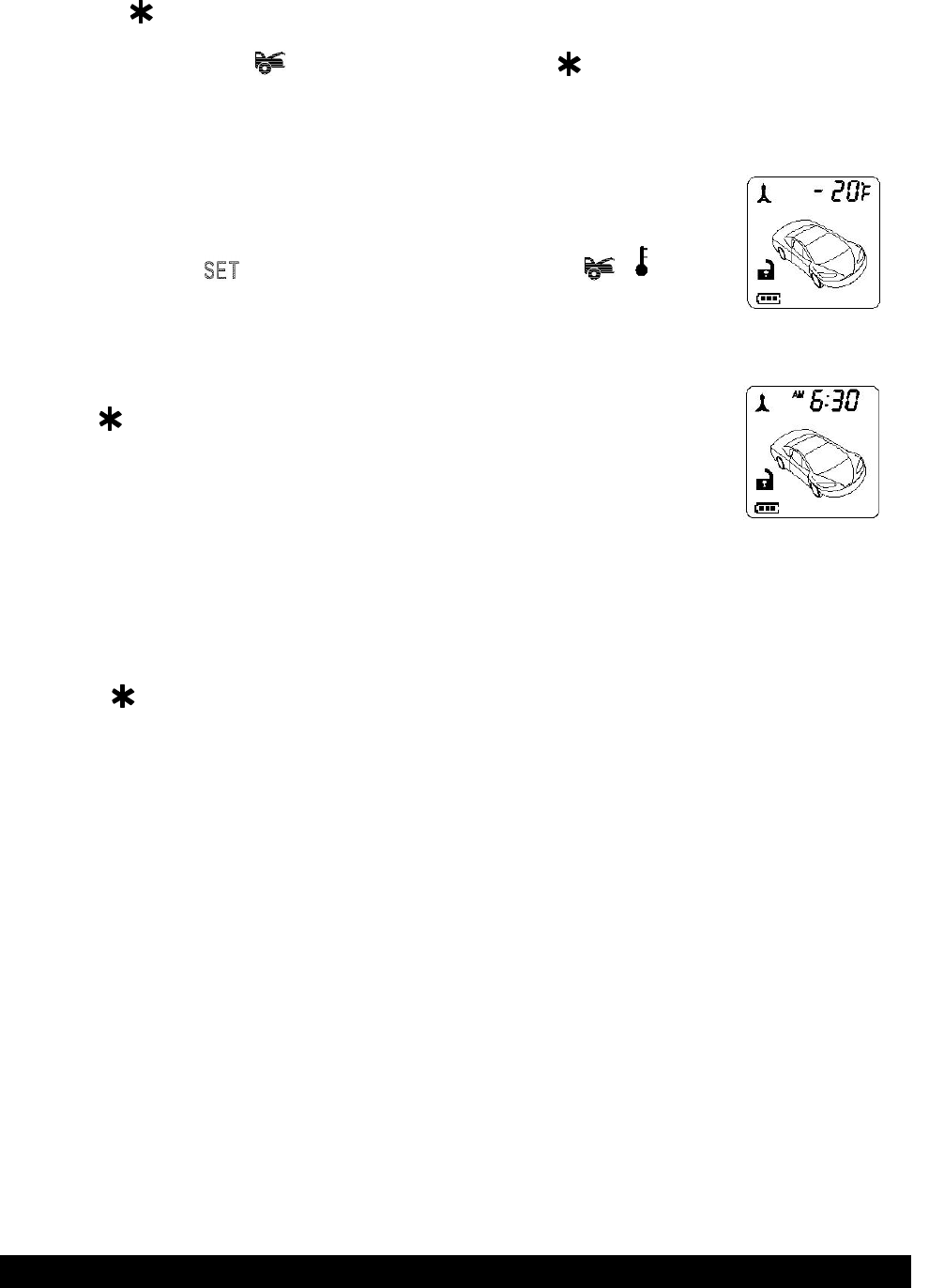
OCT/11/2002
RST871A OP 12
1. Make sure the remote start system is not operating the engine.
2. Turn the ignition on. The LED and parking light will flash (4) times. The horn chirps (4) times.
Or
1. Press the button twice to remote start the vehicle. As soon as the vehicle is running and the parking
light have turned on or flashing.
2. Immediately depress the button then press and hold the button for 2 seconds. The parking light
will flash (4) times. The siren or horn chirps (4) times. The vehicle is no longer programmed to start
automatically.
E. TEMPERATURE CHECK (OPTIONAL)
If you installed the optional temperature sensor, you can monitor, Through the LCD
screen, the present indoor temperature of the passenger compartment before cooling or
heating your vehicle.
Press the transmitter buttons first, within 3 seconds press the ( )
buttons,
the in-door temperature will be shown on the LCD screen.
F. TO TURN OFF THE REMOTE START:
When the engine is running (by remote start), if you want to stop it,
1. Press button twice on the remote transmitter under remote start mode.
2. Move the optional remote start enable toggle switch to OFF position. (If installed)
3. Press the brake pedal
The vehicle will shut down and turn off the parking light to indicate engine stopped.
G. SHUT-DOWN INPUT FOR REMOTE STARTER:
If any of the following conditions exist while the system is operating, the engine will not start or will shut down
immediately:
1. The hood is opened.
2. The brake pedal is pressed.
3. Engine is over-revved. {“Tachometer checking type” only}
4. The pre-programmed run time (5 /10 / 20 / 30 minutes) has elapsed.
5. Press button twice on the remote transmitter under remote start mode .
6. Move the optional remote start enable toggle switch to OFF position. (If installed)
7. The vehicle refused to start running after {3} unsuccessful attempts.
H. DISABLING THE REMOTE START SYSTEM: (If installed)
This feature allows your system’s remote start unit to be temporarily disabled to prevent the vehicle from
being remote started accidentally. This feature is useful if the vehicle is being serviced or stored in an
enclosed area. To disable the remote start, move the optional remote start enable toggle switch to the OFF
position.
LCD REMOTE CONTROL TRANSMITTER:

OCT/11/2002
RST871A OP 13
Note: If the system is interfered by stronger radio
frequency around, sources of high voltage electric
power or such Obstacles like tall buildings and so
on, the transmission range may get shorter as the
system uses low out put powered frequency.
A. BATTERY REPLACEMENT:
A 1.5V type AAA Alkaline battery powers the Remote Transmitter.
When the power of the battery weakens a icon shall be
displayed on the LCD screen. When the old battery is replaced to
new one, there will be beep sounds indicate the power is up and
the clock on the LCD screen returns to AM12:00 after displaying
all the icons.
Correct the time by pressing for 3 seconds before using
(See Timer Setting).
B. THE REMORE LCD ICONS WITH FUNCTION:
Door Lock
Your vehicle doors are locked
Door Unlock
Your vehicle doors are unlocked and
the system is Disarmed
Armed Mode
Your vehicle is in armed mode
Valet Mode
All the function shall be temporarily on
hold.
Remote Transmission
You are transmitting the signal to
control unit
In – Range Indicator
Your are within the remote control
range.
Door Open Warning
Doors are illegally opened (Zone 3)
Trunk/Hood Trigger
Trunk or Hood is illegally opened
(Zone 2)
Shock Sensor Trigger
Trigger on Shock Sensor (Zone 4)
Warn Away trigger
Trigger on Shock Sensor (Zone 1)
Engine Starting
Your vehicle engine starting by
remote control
Engine Running
Your vehicle's engine is running
Timer Control Start
Engine start automatically at the
same time next day or every 3-hour.
Temperature Monitor
Indoor temperature of your vehicle
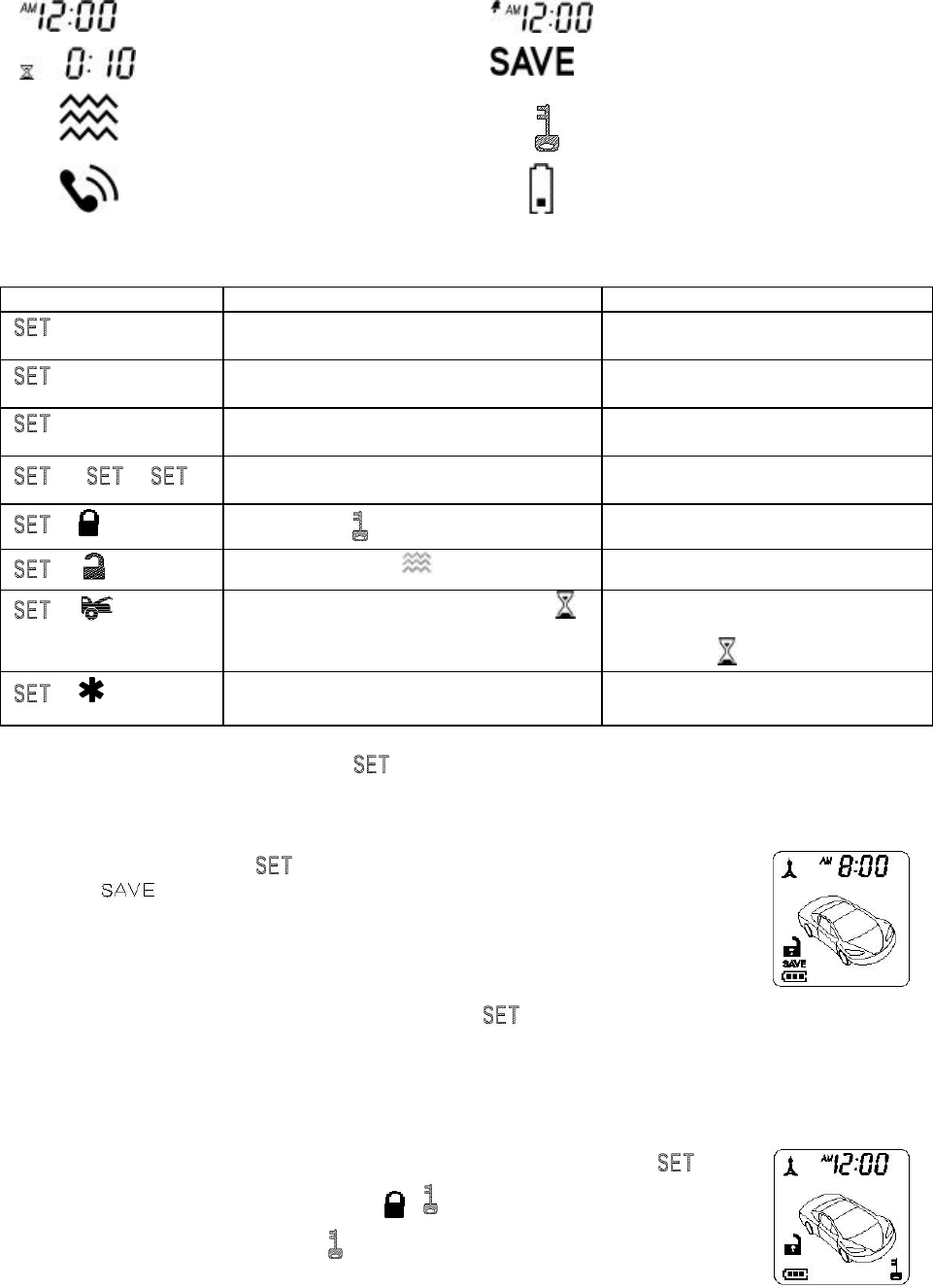
OCT/11/2002
RST871A OP 14
Time Monitor
Alert Alarm
You have set morning call alarm
Count Down Timer
Reminder when time is up for parking Power Save Mode
Save the battery power
Vibration Mode
Remote Control vibrates when the
system is triggered
Button Lock
Disable the transmission function
temporarily
Driver paging
Someone is paging you in front of
your vehicle
Low Battery
You have to replace the battery of
remote control.
C. PROGRAMMING OF THE LCD REMOTE TRANSMITTER:
Transmitter Button Description Operation
(1 second) LCD screen lamp turns on for
5 seconds. Press and hold for 1 second
1 melody sound to confirm enters.
(3 seconds) Timer Programming Mode. Press and hold for 3 seconds
2-melody sounds to confirm enter.
(5 seconds) Power Save Mode Press and hold for 5 seconds
1 melody sound to confirm enters.
- -
Clear the Flash Icon and Melody Sound on
the LCD Screen Transmitter Press within 3 seconds
-
(2-second) Button Lock ( ) enable / disable Press within 3 seconds
-
(2-second) Melody / Vibration ( ) Mode Press within 3 seconds
-
(2-second)
Program Count Down Timer ( )
(10-Minute / 20M / 30 M /1Hour /1.5H /
2.0H)
Press within 3 seconds cycling
*leave the buttons starting count
down then flashes
-
(2-second)
Enable / Disable Bi Sound (Bi) While
Pressing Button
1. Screen Lamp ON: Press and hold the button one second, with one melody sound and the LCD
screen lamp will turns on for 5 seconds
2. Power Save Mode: While the power save mode, the LCD remote transmitter uses “0” current to save the
battery power.
Entry: 1. Press & hold the button for 5 seconds, with one melody sound and
icon on the LCD screen to indicate entry the “power save mode”.
2. Under the “Active Arming Mode” and Disarm mode. Turn the ignition switch
to on, the LCD remote transmitter will automatically entry the “Power Save
Mode”
Exit: Press any button of the LCD remote transmitter to exit the “Power Save Mode”.
3. Clear the Flash Icon and Melody Sound: Press the button 3 times within 3 seconds will clear the
flash icon and melody sound on the LCD screen transmitter
4. Stop The Trigger Melody Sound: While triggering the alarm the LCD screen will alert user through
melody sound and flashing trigger icon, press any button on the LCD remote transmitter to stop melody
sound only.
5. Button Lock: It is useful if you want to disable the transmission function of the remote control temporarily
to prevent from any inadvertent pressing of buttons by others. Press the
button
first, within 3 seconds press and hold the () button for 2 seconds to
activate or
cancel the button lock function, the
icon will displayed on the LCD screen to show
the LCD remote transmitter is on “Button Lock”.
6. Vibration / Melody Mode:
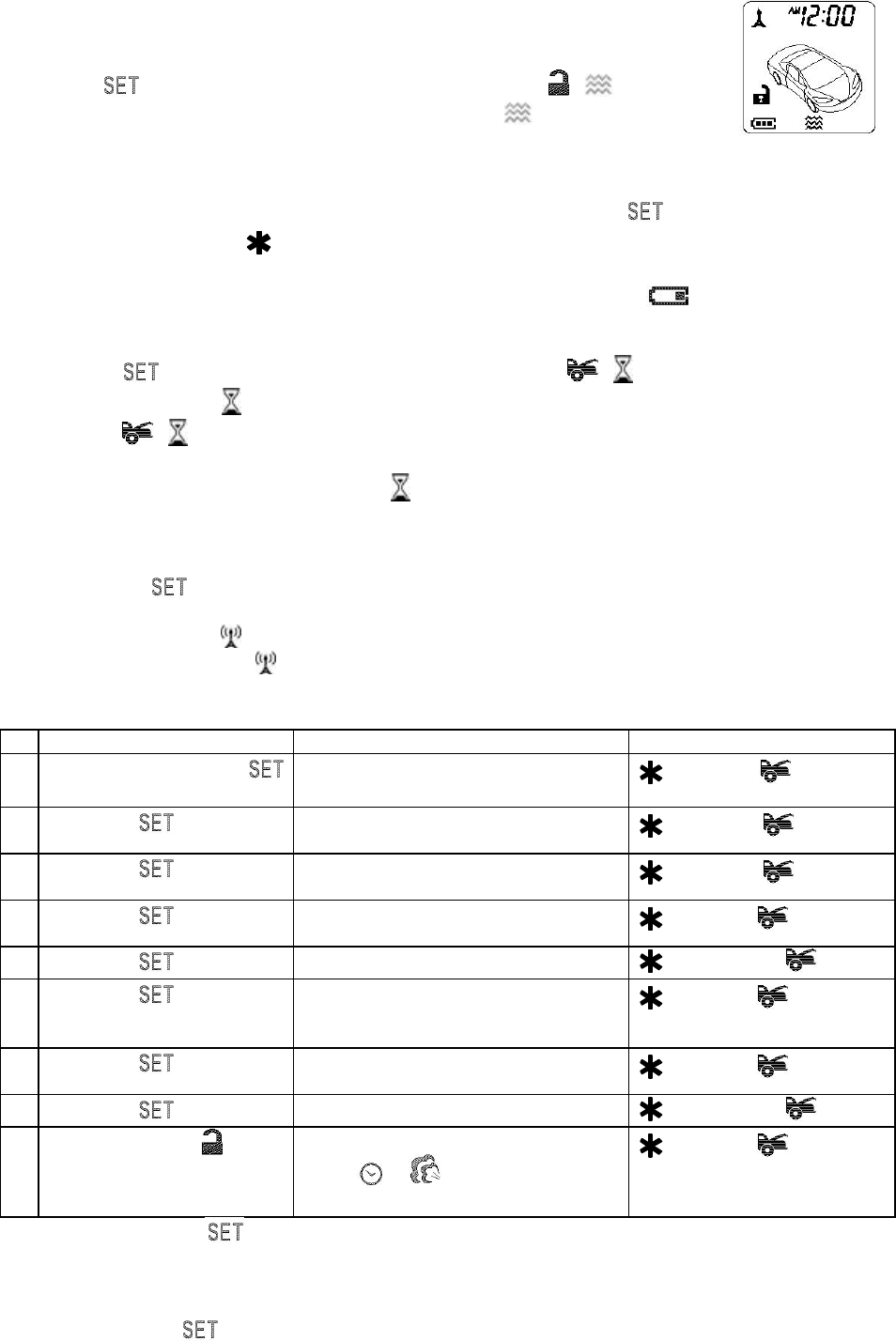
OCT/11/2002
RST871A OP 15
It is useful when you are in a noisy place and difficult to hear beep sound from the
remote control as the remote control in this mode, vibrates itself if your security system
is triggered.
Press the button first, within 3 seconds press and hold the ( ) button
for 2 seconds to select the mode of vibration or melody, the icon will displayed
on the LCD screen to show the LCD remote transmitter is on vibration mode.
7. Enable / Disable Bi Sound While Pressing Button:
It has a short “bi” sound while pressing the button of the LCD screen transmitter
If you want mute the “bi” sound mute always while press button. Press the button first, within 3
seconds press and hold the (Bi) button for 2 seconds to disable the “bi” sound.
8. Low Battery Indication:
When the power of the battery weakens, it has two short “bi” sound and flash icon while pressing the
button of the LCD screen transmitter.
9. Set Up Fixed Count Down Timer:
1. Press the button first, within 3 seconds press and hold the () button for 2 seconds, the
LCD screen will shows icon and timer (ie. 0:10) ,
2. Press the () button again showing next order time on the screen ( ie.0:20), press them again
(ie.0:30)…..and so on.
3. Leave the buttons starting count down then icon flashes
Note: 1.The count down period is fixed as 10 minutes, 20 minutes, 30 minutes, 1 hour, 1.5 hours and 2
hours maximum.
2.When count down timer showing 0:00 means to turn off the timer.
3. Press button for real time indication when the timer is counting down.
10. Out Of Range Indication:
1. If within the range, the icon will display on the LCD screen.
2. If you are out of range, the icon will disappear on the LCD screen.
D. TIMER SETTING:
Transmitter Button Description Press Transmitter Button
1 Press & Hold the
button for 3 seconds
Timer Setting (Hour)
*Flash digit for adjusting for
–
and for
+
Press the button once Time setting (Minute)
*Flash digit for adjusting for
–
and for
+
2 Press the
button once.
Alert Alarm Time Setting (Hour)
*Flash digit for adjusting for
–
and for
+
Press the button once Alert Alarm Time Setting (Minute)
*Flash digit for adjusting for
–
and for
+
Press the button once Alert Alarm Setting ON / OFF for OFF and for ON
3 Press the button once Count Down Timer Setting (Hour)
*Flash digit for adjusting
(Max.19 hours 59 minutes)
for
–
and for
+
Press the button once Count down Timer Setting (Minute)
*Flash digit for adjusting for
–
and for
+
Press the button once Count down Timer Setting ON / OFF for OFF and for ON
4 Press & hold the button
for 2 seconds.
Daily Timer Start Timer Setting
Flash / icon and “Hours” for
adjusting
for
–
and for
+
EXIT: Press and hold the button for 2 seconds or leave it for 10seconds, the system will exit the
programming mode.
1. Timer Setting: Example to AM10:30
1. Press & hold the button for 3 seconds, with two-melody sound and the “Hours” digit flashes for
adjusting.
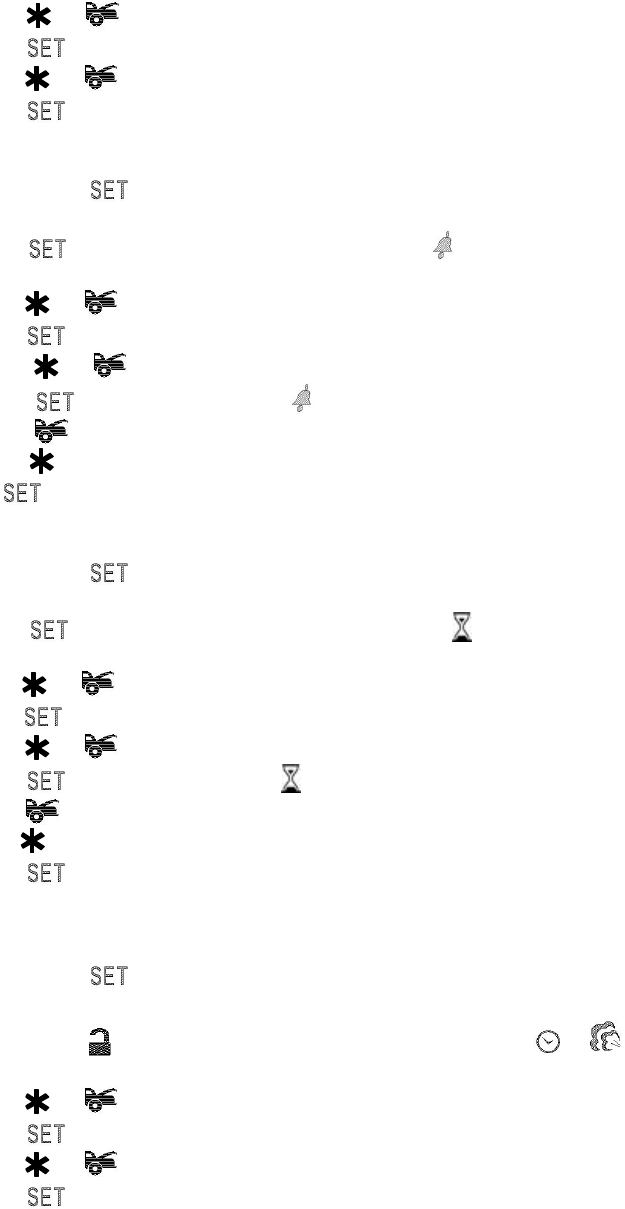
OCT/11/2002
RST871A OP 16
2. Press the or button to decrease or increase the “Hour” digit until AM10:xx
3. Press the button once again then the “Minute” digit flashes for adjusting.
4..Press the or button to decrease or increase the “Minutes” digit until AM 10:30
5. Press the button for 2 seconds with one-melody sound to confirm exit the timer program mode.
2. Alert Alarm Timer Setting: Example to PM 6:30
1. Press & hold the button for 3 seconds, with two-melody sound and the “Hours” digit flashes for
adjusting.
2. Press the button twice, the LCD screen will shows icon and “Hours” digit is flashes for
adjusting.
3. Press the or button to decrease or increase the “Hour” digit until PM 6:xx
4. Press the button once again then the “Minutes” digit flashes for adjusting.
5. Press the or button to decrease or increase the “Minutes” digit until PM 6:30
6. Press the button once again then icon flashes for alert alarm “ON / OFF” setting
7. Press the button to start the “Alert Alarm Timer”, and the “ON” icon will show on the LCD screen.
Press the button to stop the “Alert Alarm Timer”, and the “OFF” icon will show on the LCD screen.
8. Press button for 2 seconds with one-melody sound to confirm exit the timer program mode.
3. Count Down Timer Setting: Example Set count down timer at 2:30
1. Press & hold the button for 3 seconds, with two-melody sound and the “Hours” digit flashes for
adjusting.
2. Press the button 5 times, the LCD screen will shows icon and “Hours” digit is flashes for
adjusting.
3.Press the or button to decrease or increase the “Hour” digit until 2:xx
4.Press the button once again then the “Minutes” digit flashes for adjusting.
5. Press the or button to decrease or increase the “Minute” digit until 2:30
6. Press the button once again then icon flashes for alert alarm “ON / OFF” setting
7. Press the button to start the count down timer, and the “ON” icon will show on the LCD screen.
Press the button to stop the count down timer, and the “OFF” icon will show on the LCD screen.
8. Press the button for 2 seconds with one-melody sound to confirm exit the timer program mode.
Note: Maximum is 19 hours.
4. Time Set-Up For “Daily Timer Start”: Example to AM 6:30
1. Press & hold the button for 3 seconds, with two-melody sound and the “Hours” digit flashes for
adjusting.
2. Press & hold the button for 2 seconds, the LCD screen will flash / icon and “Hours”
digit for Hour set-up.
3. Press the or button to decrease or increase the hour digit until AM 6:00
4. Press the button once again then the minute digit flashes.
5. Press the or button to decrease or increase the minutes digit until AM 6:30
6. Press the button for 2 seconds with one-melody sound to confirm exit the timer program mode.
OCT/11/2002
RST871 OP 17
This device complies with part 15 of the FCC rules. Operation is subject to the following two conditions/:-
(1) This device may not cause harmful interference
(2) This device must accept any interference received: including interference that may cause undesired
operation.
Note: The manufacturer is not responsible for any radio TV interference caused by unauthorized modification to
this equipment. Such modifications could void the user’s authority to operate the equipment.
OCT.09, 2002
RST871A
1
MODEL RST871A
REMOTE ENGINE STARTER
WITH ALARM SYSTEM
INSTALLATION MANUAL

OCT.09, 2002
RST871A
2
HJKL
TABLE OF CONTENTS:
INSTALLATION DIAGRAM …………….……………………………………………….………………………….... 4
H1: 6 PIN HEAVY GAUGE WIRING CONNECTION …………………………….………………..…….……… 6
H1/1 Violet Wire – Starter Output ………………….…………………………….……………………….….….. 6
H1/2 & H1/3 Red Wire – +12V Power Input ………………………………….…………………...……………. 6
H1/4 Yellow Wire – Ignition 1 Output ……………………….…………………….……..…….…..…….………. 6
H1/5 Pink Wire – Ignition 2 Output ……………………………….…………….……..…….…..…….…………. 6
H1/6 Brown Wire – Accessory Output (Heater /ACC Output) ………………….……..……...….……………. 6
H2: 5 PIN WIRE HARNESS …..………………………………………………………….………………..…………. 7
H2/1 Red / White wire – Parking Light Relay Power Input ……………………….……..……...….….………..7
H2/2 White wire – Parking Light Relay Output ………………………………….……..………….….………… 7
H2/3 Black wire – System Ground ……………………………………………….……..………………...……… 7
H2/4 Brown wire – Siren Drive Output ………..………………………………….……..…………..…………….7
H2/5 Red wire – System Power ………………….…………………………….………………..………………...7
H3: BLACK 4-PIN CONNECTOR FOR TWO-WAY TRANSCEIVER/ANTENNA MODULE ……….…….…... 7
H4: 3-PIN BROWN CONNECTOR FOR OPTIONAL PAGING (KNOCK) SENSOR ……………………....….. 7
H5: 9 PIN MINI BLACK INPUT WIRE CONNECTOR …..………………………………………………….……... 7
H5/1 White / Black wire – Negative Safety Shut Down Input (Hood -) .……….………………….….…..…… 7
H5/2 White / Violet wire – Positive Safety Shut Down Input (Brake +) ..…….….………………………..…... 8
H5/3 Black / White wire – (-) Remote Start Enable Toggle Switch Input …….………………………..……... 8
– (-) Neutral Safety Switch Input ………………….…………………………….…..… 8
H5/4 Blue wire – Ground Instant Trigger Input (Zone 2) .……………………….………………...………...…. 8
H5/5 White / Green wire – (-) Diesel Wait – To - Start Input ………………….……..………..…………..….. 8
H5/6 Green wire – Negative Door Switch Sensing Input (Zone 3) .………….………………..…….….….…. 8
H5/7 Violet Wire – Positive Door Switch Sensing Input (Zone 3) .………….………………..………...……... 9
H5/8 White / Blue wire – (-) Instant Start & Turn Off Input ………………….……………………….…..…..... 9
H5/9 White / Red wire – Tachometer Signal Connection ……….……………………..……….……………... 9
H7. 4 PIN ORANGE CONNECTOR FOR 2 STAGE SHOCK SENSOR (ZONE 1 / 4) ….…………….…..….... 9
H8: 10-PIN MINI WHITE OUTPUT WIRE CONNECTOR ……………………………………………….…..…..... 9
H8/1 Yellow wire – (-) 200ma Ignition 3 Output ….………………………….………………..……..….…..... 9
Transponder Interfacing
GM VATS Key Override
H8/2 Black / Violet wire – (-) 200mA Timer Control Channel 6 Output ……….…………………..…...……. 10
H8/3 Brown / White wire – (-) 200ma Programmable Output ……………….……………...….…..….….…. 10
Horn Output – (Factory Default Setting)
Factory Security Rearm Signal Output
H8/4 White wire – (-) 200ma Dome Light Control Output ……………….………………..……….…....……. 10
H8/5 Black / Red wire – (-) 200mA Timer Control Channel 5 Output ……….………………….…..………. 11
H8/6 Black / Green wire – (-) 200mA Programmable Output …………….….…………….…..………....…. 11
Programmable Timer Channel 4 Output – (Factory Default Setting)
Key Sensor By-Pass Output
H8/7 Gray wire – (-) 200ma Channel 3 Output ….…………………………….……………..………………... 11
H8/8 Pink wire – (-) 200ma Programmable Output …………………………….……………….…………….. 11
2 Steps Unlock Output (Factory default setting)
Factory Security Disarm Signal Output
Start Status (Shock Sensor By-Pass Control) Output ……………….………………..………………. 11
H8/9 Orange / White wire –(-) 200ma Grounded Output When Disarmed ……….………..…………….. 11
H8/10 Orange wire – (-) 200ma Grounded Output When Armed ……………….…………..………………. 11
H9. 3 PIN GREEN CONNECTOR FOR OPTIONAL TEMPERATURE SENSOR ……………..…....……..…. 12
H10. 2 PIN BLUE CONNECTOR FOR THE VALET SWITCH .……………………………… ….……...…..…. 12
H11. 2 PIN WHITE CONNECTOR FOR THE LED STATUS INDICATOR ………………….…..…..…..….…. 12
H6. 3 PIN DOOR LOCK CONNECTOR ………………………..…………………………………………...…..…. 12
Install New Door Lock Motors ….…………………………….…………………….……………..……...…..…. 12
Negative Trigger Door Lock System .…………………………….……………………….……………....……. 12
Positive Trigger Door Lock System ….…………………………….…………………….…………….…….…. 12
Alternating Door Lock System ….………………………………….…………………….……………..…….…. 13
Vacuum Operate Door Locking System ….…………………………….……………….……………..………. 13
2 Steps Door Unlock Wire Connection For 5 Wires Alternating Door Lock System ….……….…….…..…13
2 Steps Door Unlock Wire Connection For Ground Switched Door Lock System ….………..…….…….…13

OCT.09, 2002
RST871A
3
2 Steps Door Unlock Wire Connection For Positive Switched Door Lock System ….………..……….……13
PROGRAMMING & TESTING:
A. PROGRAMMING THE REMOTE TRANSMITTER …………………………………………………………..…14
B. FEATURES PROGRAMMING ……..…………………………………………………………………………..... 14
Alarm Feature “I” Programming ……………………………………………….………..………..…...……….... 14
3 / 30 seconds Delay Door Ajar Error Chirp …………………………………..….…………………..….... 15
45 second Door By-Pass (With Dome Light Turn On After Ignition Off) …………………..………….... 15
Alarm Feature “II” Programming ……………………………………………….…………………..………….... 15
Alarm Feature “III” Programming ……………………………………………….…………………..…………... 15
Channel 4 (5 / 6) Timer Control Output Programming ………………….…………………...………....… 16
Key Sensor By-Pass Output Programming ………………….…………………...……………..……….… 17
Password Pin Code Setup ………………………………………………….…………………..………….… 17
Start Feature “I” Programming ……………………………………………….…………………..…………....... 18
Safe Start (Child Safety Mode) ………………………………………………………………..……….…..... 18
Start Feature “II” Programming ……………………………………………….…………………..…………….. 18
Tachometer Checking Type – RPM Learning & Testing ……………………………………………...….. 19
Voltage Checking Type – Start Timer Set-up & Testing ……………………….…………………………. 19
Timer Checking Type – Start Timer Set-up & Testing …………….…………….………………………... 20
Test Mode ………………………………………………………………………………………..…………..... 21
RETURN TO FACTORY DEFAULT SETTING ………………………………………..……………..…….…….. 21
SHUTDOWN DIAGNOSTICS ………………………………………..……………………….……….…………..... 21
TESTING YOUR INSTALLATION ………………………………………..……………..………………………..... 22
Test the Brake shutdown circuit…………………………………………….……………………..…………….... 22
Test the Hood Pin shutdown circuit………………………………………….…………………..……….……..... 22
Neutral Start Safety Test ……………..……………………………………….…………………..……….……… 22
Mechanical Neutral Safety Switch Considerations ………………………….…………………..……………… 22
Park/Neutral ECM Input ……….……………………………………………….…………………..……………… 22
Key In Sensor Circuits ……………………………………………….…………………..…………………...…… 23
INTRODUCTION
INSTALLER WARNINGS
This Remote Starter with Alarm System is designed to be installed on fuel injected vehicles with an automatic
transmission ONLY.
n Never install this remote starter on a manual transmission vehicle.
n This system must be installed and wired through a safety switch it will not start in any forward or reverse
gear.
n Some automatic transmission vehicle [mainly older GM vehicles with a purple starter wire] have a
mechanical-type park safety switch instead of electrical safety switch. The mechanical type does not interrupt
the starter circuit when the transmission is any gear and does not offer the 100% level of safety required for
remote starting purposes. Therefore, our system should never be installed on any vehicle that uses a
mechanical type park safety switch.
n Once you install this system, you must verify that the vehicle will not start any forward or reverse gear.
Regardless of the type of vehicle.
n Read operation manual for operating and programming routine.
n Do not install any component near the brake, gas pedal or steering linkage.
n Some vehicles have a factory installed transponder immobilizer system that can severely complicate the
installation. There is possibility that this system can not be installed on some immobilizer equipped vehicles.
n Most vehicles have an SRS air bag system. Use extreme care and do not probe any wires of the SRS
system.
n Disconnect the car battery before connecting work on the vehicle.
n Check behind panels before drilling any holes. Ensure that no wiring harness or other components are
located behind the panels that would otherwise be damaged.
n Use conventional crimp lock, bullet on any wiring. Poor wiring, i.e. taped joints will possibly introduce
unreliability into the alarm system and may result in false alarms or incorrect operation.
n Install wiring neatly under carpets or behind trim to prevent possible damage to wires.
n For the wire operates the current more than 10A. We suggest soldering all connection point. Do not use
crimp lock type connectors or wire nuts.
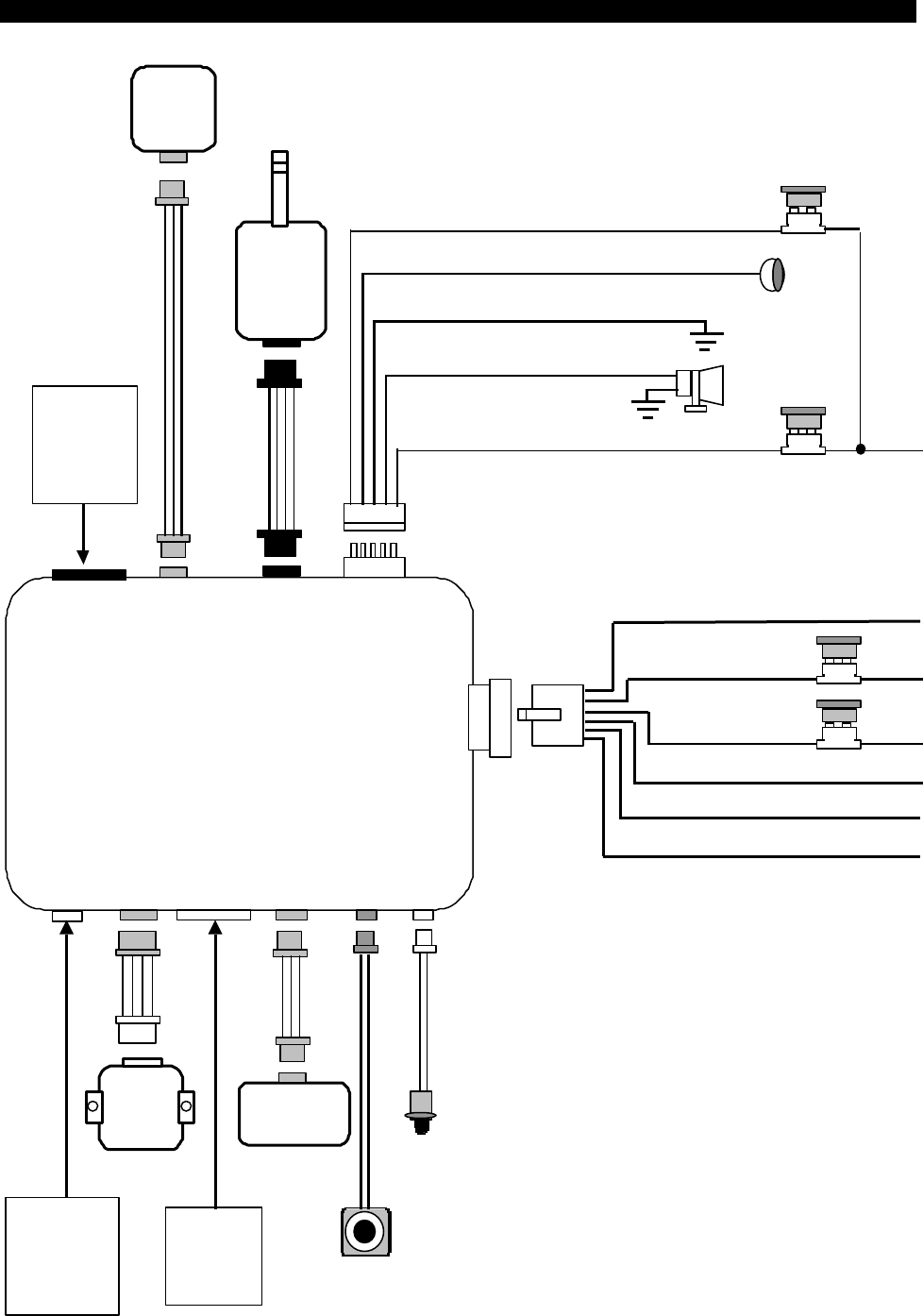
OCT.09, 2002
RST871A
4
INSTALLATION DIAGRAM
H 5
9 Pin Black
Connector
For Input
Connection
H 1
6 Pin
White
H 2
5 Pin
White
H 11
2 Pin
White
H 3
4 Pin
Black
H 4
3 Pin
Brown
H 5
9 Pin
Black
VALET
SWITCH
H 8
10 Pin
White
H 9
3 Pin
Green
H 10
2 Pin
Blue
1. Red / White:
Turn Indicator Relay Power input
2. White: Parking Light Relay Output
3. Black: Ground to Vehicle Frame
4. Brown: Positive Output to Siren
5. Red: +12V Input
Two Way
Transceiver
Antenna
LED
Indicator
3A Fuse
10A Fuse
2. Red: +12V Input
3. Red: +12V Input
4. Yellow:
Ignition 1 output
1. Violet:
Starter Output
20A
Fuse
20A
Fuse
5. Pink: Ignition 2 Output
H 7
4 Pin
Orange
Dual
Zone
Shock
Sensor
H 6
3 Pin
White
H 8
10 Pin White
Connector
for Output
Connection
H 6
3 Pin White
Connector for
Door Lock &
Door unlock
Connection
Optional
Pager
(Knock)
Sensor
Optional
Temperature
Sensor
6. Brown:
ACC/Heater Output
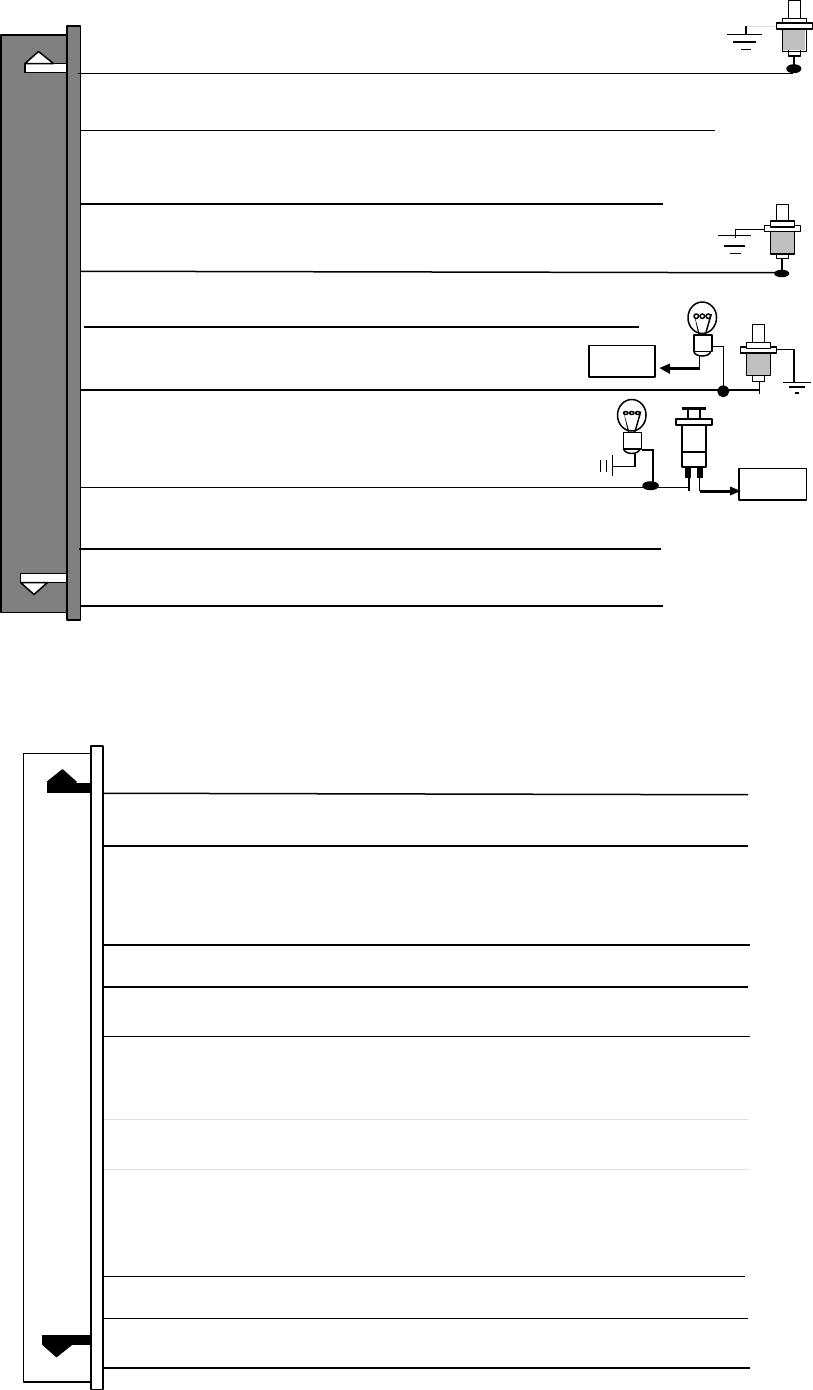
OCT.09, 2002
RST871A
5
#H5. 9 PIN BLACK CONNECTOR FOR INPUT CONNECTION:
6. Green Wire: Zone 3 / Negative Door Pin Trigger Input:
4. Blue Wire: Zone 2 / Instant Trigger Ground
7. Violet Wire: Zone 3 / Positive Door Pin Trigger
2. White / Violet Wire: (+) Positive Safety Shut Down Input for Brake switch.
3. Black/White Wire: (-) Neutral Safety Switch Input &
(-) Remote Start Toggle Switch Input
9. White / Red Wire: Tachometer Signal Input
+12V
1. White / Black Wire: (-) Negative Safety Shut Down Input for Hood pin switch
IMPORTANT NOTE: Directly connect the H5/3 BLACK/WHITE wire to the “GROUND” when this wire
is not used.
+12V
5. White / Green Wire: (-) Diesel Wait-To-Start Input
8. White / Blue Wire: (-) Instant Start and Turn Off Input
#H8. 10 PIN WHITE CONNECTOR FOR OUTPUT CONNECTION
4. White Wire: (-) 200mA Dome Light Control Output
7. Gray Wire: (-) 200mA Channel 3 (Trunk) Output
10. Orange Wire: (-) 500mA Grounded Output When Armed
1. Yellow Wire: (-) 200mA Ignition 3 Control Output
8. Pink Wire: (-) 200mA Programmable Output
1. 2 Steps Door Unlock Output (Factory Default Setting) or
2. Factory Security Disarm Signal Output or
3. Start Status (Shock Sensor By-Pass Control) Output
3. Brown / White Wire: (-) 200mA Programmable Output
1. Horn Output (Factory Default Setting) or
2. Factory Security Rearm Signal Output
6. Black / Gree n Wire: (-) 200mA Programmable Output
1. Channel 4 Programmable Output (Factory Default Setting) or
2. . Key Sensor By-Pass Output
2. Black / Violet Wire: (-)200mA Channel 6 Programmable Output
5. Black / Red Wire: (-) 200mA Channel 5 Programmable Output
9. Orange / White Wire: (-)200mA Grounded Output When Disarmed
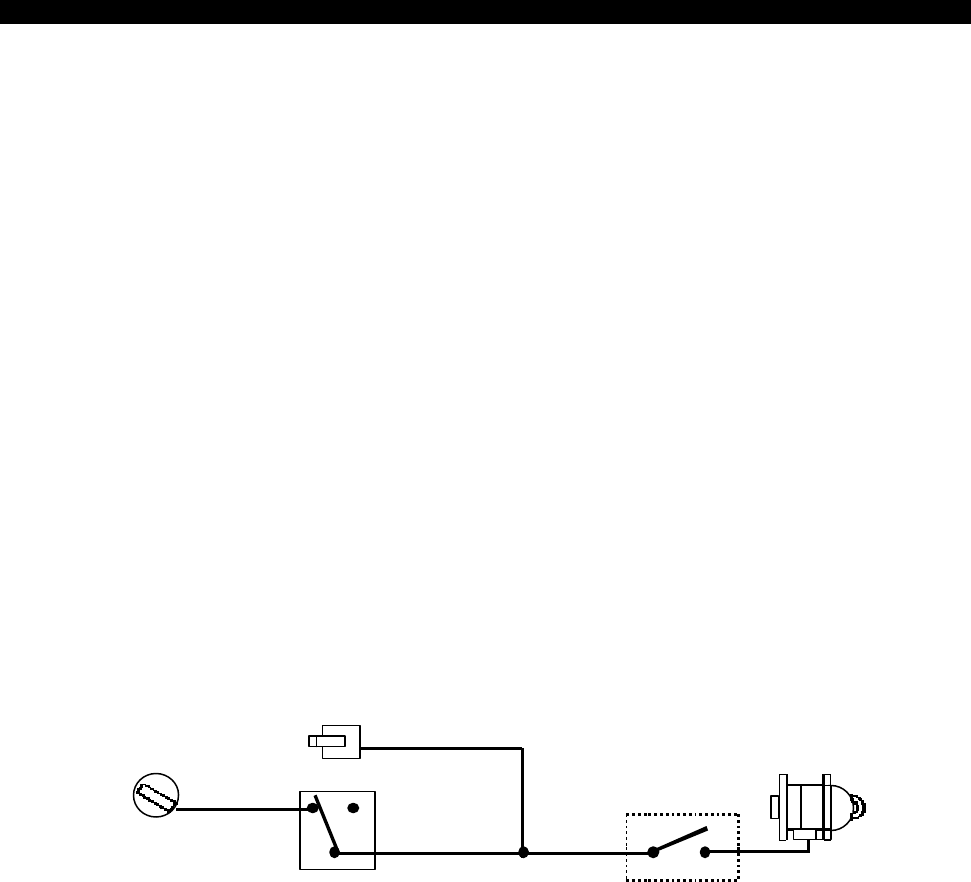
OCT.09, 2002
RST871A
6
WIRING
Keep wiring away from moving engine parts, exhaust pipes and high-tension cable. Tape wires that pass
through holes on the firewall to prevent fraying. Watches out sharp edges that may damage wires and causes
short circuit.
CAUTION: Do not connect the wire harness to the control module until all wiring to vehicle is complete.
H1: 6 PIN HEAVY GAUGE WIRING CONNECTIONS:
Remember that the system does to start a vehicle is duplicate the functions of the ignition key switch! Below,
we will explain the three basic functions of the ignition switch. Since this installation will require analysis of the
ignition switch functions, we recommend making the three connections below at the ignition switch harness
directly.
H1/1 Violet wire – Starter Output –
Careful consideration for the connection of this wire must be made to prevent the vehicle from starting while in
gear. Understanding the difference between a mechanical and an electrical Neutral Start Switch will allow you
to properly identify the circuit and select the correct installation method. In addition you will realize why the
connection of the safety wire is required for all mechanical switch configurations.
Failure to make this connection properly can result in personal injury and property damage.
In all installations it is the responsibility of the installing technician to test the remote start unit and assure
that the vehicle can not start via RF control in any gear selection other than park or neutral.
In both mechanical and electrical neutral start switch configurations; the connection of the VIOLET wire will
be made to the low current start solenoid wire of the ignition switch harness. This wire has +12 volts when
the ignition switch is turned to the “START” (CRANK) position only. This wire have 0 volts in all other ignition
switch positions.
NOTE: This wire must be connected to the vehicle side of the starter cut relay (when used). For the electrical
neutral switch configuration, this connection must be made between the starter inhibit relay (when used) and
the neutral safety switch as shown in the following diagram.
Failure to connect this wire to the ignition switch side of the neutral safety switch can result in personal injury
and property damage. SEE NEUTRAL START SAFETY TEST FOR FURTHER DETAILS.
Start Cut Relay
(When Used)
VIOLET Wire
Closed in Park or
Neutral Only
Ignition
Switch
“Start”
“On” Neutral Safety
Switch
“Acc”
“Off” Starter
H1/2 & H1/3 Red wire – +12V Power Input –
Remove the two 20A fuses prior to connecting these wires and do not replace them until the satellite has
been plugged into the control module. These wires are the source of current for all the circuits the relay
satellite will energize. They must be connected to a high current source. Since the factory supplies (+) 12V
to the key switch that is used to operate the motor, it is recommended that these wires be connected there.
Note: If the factory supplies two separate (+) 12V feeds to the ignition switch, connect one RED wire of the
satellite to each feed at the switch.
H1/4 Yellow wire – Ignition Output –
Connect the YELLOW wire to the ignition wire from the ignition switch. The ignition wire should receive "12
volts" when the ignition key is in the "ON" or “RUN” and "START" or “CRANK” position. When the ignition is
turned "OFF", the ignition wire should receive "0" voltage. The YELLOW wire must be connected.
H1/5 Pink wire – Ignition 2 Output
Some vehicles have [2] ignition wires that must be power. Connect the PINK wire to the ignition 2 wire from
the ignition switch. The ignition wire should receive "12 volts" when the ignition key is in the "ON" or “RUN”
and "START" or “CRANK” position. When the ignition is turned "OFF", the ignition wire should receive "0"
voltage. If the PINK wire is not used, cap the end of the wire.
H1/6 Brown wire – Accessory Output (Heater /ACC Output) –
Connect the BROWN wire to the accessory wire in the vehicle that powers the climate control system.
An accessory wire will show + 12 volts when the ignition switch is turned to the “ACCESSORY” or “ON” and
“RUN” positions, and will show 0 Volts when the key is turned to the “OFF” and “START” or “CRANK” position.
There will often be more than one accessory wire in the ignition harness. The correct accessory wire will
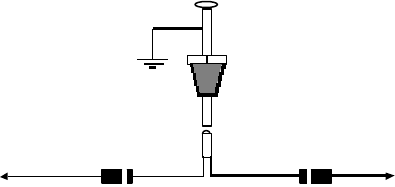
OCT.09, 2002
RST871A
7
power the vehicle’s climate control system. Some vehicle may have separate wires for the blowe r motor and
the air conditioning compressor. In such cases, it will be necessary to add a relay to power the second
accessory wire.
H2: 5 PIN WIRE HARNESS:
H2/1 Red / White wire – Parking Light Relay Power Input –
The RED/WHITE wire is the input to the flashing parking light relay. The connection of the RED/WHITE wire
will determine the output polarity of the flashing parking light relay.
If the vehicle you are working on has +12volt switched parking light, you don’t need connect this wire. This
wire already connected to +12 volt.
If the vehicle’s parking light are ground switched, cut the RED/WHITE wire, connect the RED/WHITE wire to
chassis ground.
H2/2 White wire – Parking Light Relay Output (10A power output) –
Connect the WHITE wire to the parking light wire coming from the headlight switch. Do not connect the
WHITE wire to the dashboard lighting dimmer switch. (Damage to the dimmer will result). The limitation of the
WHITE wire is 10 AMP max. Do not exceed this limit or damage to the alarm and parking relay will result.
H2/3 Black wire – System Ground –
This is main ground connection of the alarm module. Make this connection to a solid section of the vehicle
frame. Do not connect this wire to any existing ground wires supplied by the factory wire loom, make the
connection to the vehicle's frame directly.
H2/4 Brown wire – Siren Drive Output – (See Alarm Feature II - 4 Programming)
This is the positive (+) output connection for the siren. Current capacity is 2 amps. Make connection to the
(+) red wire from the siren. Make the (-) black wire coming from the siren to a good chassis ground.
H2/5 Red wire – System Power (+12V Constant) –
The RED wire supplies power to the system. Connect this wire to a constant +12 volt source.
H3. BLACK 4-PIN CONNECTOR. – TWO-WAY TRANSCEIVER/ANTENNA MODULE
The Two-way transceiver/antenna mounts on the windshield (Inside). We suggest you mount it on the lower
left or upper left-hand side of windshield.
Warning! Do not mount in such a manner that it obstructs the driver’s vi ew.
- Remove the protective tape backing.
- Carefully align the two-way transceiver/antenna and apply to windshield.
- Route the black connector wire behind the trim and connect to the two-way transceiver/antenna.
- Connect the other end to the control module.
- Special considerations must be made for windshield glass as some newer vehicles utilize a metallic
shielded window glass that will inhibit or restrict RF reception. In these vehicles, route the two ways
transceiver/antenna module away from metallic shielded window glass as far as possible.
H4. 3-PIN BROWN CONNECTOR FOR OPTIONAL PAGING (KNOCK) SENSOR
The optional Paging (Knock) Sensor can be add on.
1. Detach the protecting paper from the double-sided adhesive tape and attach one side of the double-sided
adhesive tape to the bottom part of the Paging (Knock) Sensor.
2. After cleansing the area around left bottom part of the front window so that it stays attached firmly, the
Paging Sensor should be attached on the front window so that the side on which a sticker with a printed
words “Tap Here Paging Driver” is attached face outward.
3. Hide the wire by carefully pushing it inside the space of the front window’s mold trim.
4. Adjust the sensitivity of the Paging Sensor, If you turn the tuning screw at the center of the Paging Sensor
clockwise, the sensitivity goes sharp and if turned counter-clockwise, the sensitivity goes dull.
H5: 9 PIN MINI BLACK INPUT WIRE CONNECTORS:
H5/1 White / Black wire – Negative Safety Shut Down Input –
The WHITE/BLACK wire prov
ides an instant shutdown for
the remote start, whenever it is grounded. Connect the
wire to the hood pin switch previously installed. This wire
must be routed though a grommet in the firewall and
connected to the hood pin switch. If the pin switch is to
be
used with an alarm system, connect this wire with
diode.
To: White/Black Wire /
Negative safety
To: Alarm instant
trigger Blue wire
Hood Pin Switch
Diode
Diode
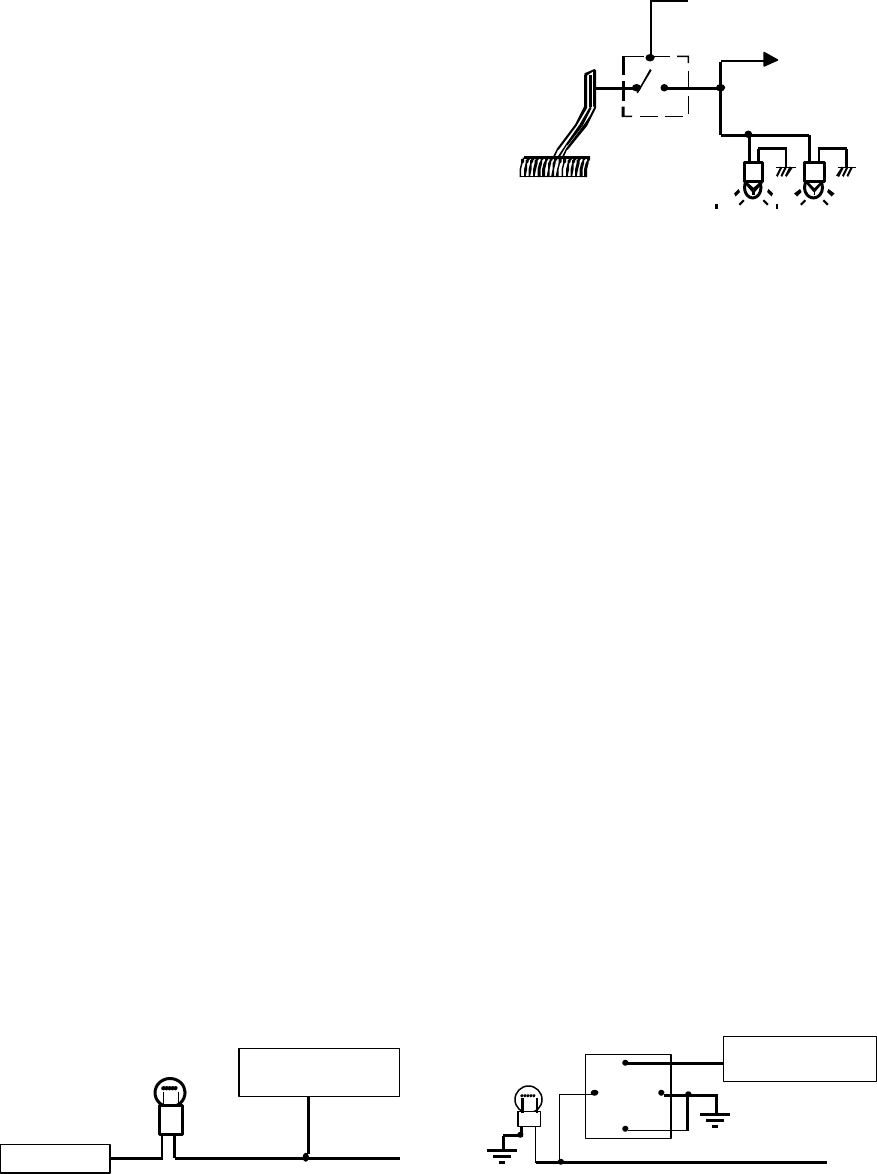
OCT.09, 2002
RST871A
8
Important! This connection is a safety wire and must be connected as shown and tested as specifiled.
Failure to do so may result in personal injury or property damage. See detail of wiring in the following
diagram. This wire may also be used if the vehicle brake light circuit switches ground to the brake lights. An
isolation diode must be used for ground switched brake light circuits and must be connected to the output of
the brake switch.
H5/2 White / Violet wire – Positive Safety Shut Down Input –
This wire provides an instant shutdown for the remote
start, whenever it gets +12volts. If the brake lights switch
in the vehicle switches +12 volts to the brake light circu
it,
connect this wire to the output side of the brake switch.
This will allow the remote start to shut down if an attempt
is made to operate the vehicle without the key while
running under the control of the remote start. In most
vehicles, in order to shif
t gear, the brake pedal must be
depressed. The brake input will in turn cause the remote
start unit to shut off. See below diagram.
+12 volts from fuse box
To White/ Violet
wire
Brake light bulbs
Switch closes
When brake is
depress
H5/3 Black/White wire – (-) Remote Start Enable Toggle Switch Input –
– (-) Neutral Safety Switch Input –
When the BLACK/WHITE wire is grounded, the remote start unit is operable. When this wire is open from
ground, the remote start is disable.
1. The optional “remote start toggle switch” can be added on to temporarily disable the Remote Start Device,
it can prevent the vehicle from being remote started accidentally. This feature is useful if the vehicle is
being serviced or stored in an enclosed area. To disable the remote start, move the optional remote start
enable toggle switch to the OFF position. To enable the remote start, move the optional remote start
enable toggle switch to the ON position.
2. If needed, This wire can connect to the PARK/NEUTRAL switch in the vehicle. (See the TESTING YOUR
INSTALLATION GUIDE)
IMPORTANT NOTE: Directly connect the BLACK/WHITE wire to the “GROUND” when this wire is not
used.
H5/4 Blue wire – Ground Instant Trigger Input (Zone 2) –
This wire is the ground trigger input wire for hood/trunk pin switches.
H5/5 White / Green wire – (-) Diesel Wait – To - Start Input –
In diesel vehicles it is necessary to interface with the wire that on the WAIT-TO-START light in the dashboard.
This wire illuminates the bulb until the vehicle’s glow plugs are properly heated. When the light goes out the
vehicle can be started. This wire is always at the connector leading to the bulb in the dashboard. It can also
be found at the Engine Control Module (ECM) in many vehicles.
To test and determine the polarity of this wire:
1. Set your multi-meter to DVC or DC voltage (12V or 20V is fine).
2. Attach the (+) probe of the meter to (+) 12V.
3. Probe the wire that you suspect leads to the bulb with the (-) probe of the meter.
4. Turn the ignition switch to the ON position.
5. If the meter indicates 12 volts until the light goes out you have isolated the connect wire and the wire’s
polarity is negative (ground while the bulb is on).
6. If the meter reads zero volts until the light goes out and then reads 12 volts, you have isolated the connect
wire and the wire’s polarity is positive.
Connect this wire to the wire in the vehicle that sends the signal to turn on the WAIT-TO-START bulb in the
dashboard. In most diesels the wire is negative (ground turns on the bulb) and this wire can be directly
connected to the wire in the vehicle. If the vehicles use a positive wire (12V to turn the bulb) a relay must be
used to change the polarity.
(-) Wait To Start Wire
Wait to Start
Indicator
Ignition (+)
White/Green Wire
Wait To Start Input
87a
86
87
30
85
(+) Wait To Start
Wait To Start
Indicator
White/Green Wire
Wait To Start Input
H5/6 Green wire – Negative Door Switch Sensing Input (Zone 3) –
This wire is the ground trigger input wire for negative door pin switch. This wire is connection for "grounding"
type factory door pins locate the "common wire" that connects the door pin switches. Make the connection
of the GREEN Wire here.
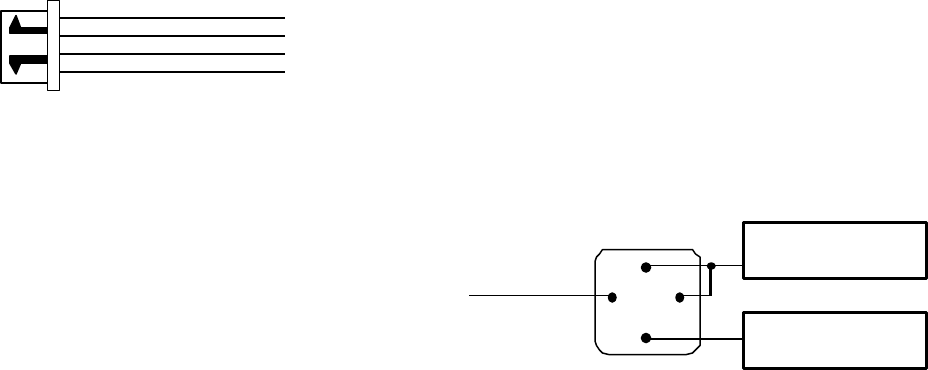
OCT.09, 2002
RST871A
9
H5/7 Violet wire – Positive Door Switch Sensing Input (Zone 3)–
This wire is the positive trigger input wire for positive door pin switch. This wire is connection for "positive"
type factory door pins(typical FORD MOTOR). Locate the "common wire" for all door pins and make the
connection of the VIOLET Wire here.
H5/8 White / Blue wire – (-) Instant Start & Turn Off Input –(See Start Feature I - 6 Programming)
This wires activates and turns off the remote starter each time it sees a momentary ground signal. Normally
only used for testing during installation or when activating the module from an after-market system.
H5/9 White / Red wire – Tachometer Signal Connection –
Note: You should connect this wire if you program the Start Feature II – 2 to “Tachometer checking type”,
otherwise not to connect this wire and tap the end.
Note: No connection of this wire is required, if you use the voltage or timer checking type mode.
This input provides the remote start system with information about the engine’s revolutions per minute (RPM).
It can be connected to the negative side of the coil in vehicle with conventional coils. In multi-coil and high
energy ignition system locating a proper signal may be more difficult. Once connected,
To test for a tachometer wire, a multi-meter capable of test AC voltage must be used. The tachometer wire
will show between 1V and 6V AC at idle, and will increase as engine RPM increases. In multi-coil ignition
system, the system can learn individual coil wire. Individual coil wires in a multi-coil ignition system will
register lower amounts of AC voltage. Also, if necessary, the system can use a fuel injector control wire for
engine speed sensing. Common locations for a tachometer wire are the ignition coil itself, the back of the
gauges, engine computers, and automatic transmission computers.
IMPORTANT! Do not test tachometer wires with a test light or logic probe. The vehicle will be damaged.
How to find a tachometer wire with your multi-meter
1. Set the ACV or AC voltage (12V or 20V is fine.)
2. Attach the (-) probe of the meter to chassis ground.
3. Start and run the vehicle.
4. Probe the wire you suspect of being the tachometer wire with the red probe of the meter.
5. If this is the correct wire the meter will read between 1V and 6V.
H7. 4 PIN ORANGE CONNECTOR FOR 2 STAGE SHOCK SENSOR (ZONE 1 / 4)
1. Green Wire / Zone 1 Warn Away Input
2. Blue Wire / Zone 4 Ground Trigger
3. Black Wire / Negative
4. Red Wire / +12Volts
H8: 10-PIN MINI WHITE OUTPUT WIRE CONNECTOR:
H8/1 Yellow wire – (-) 200ma Ignition 3 Output –
This wire provides a 200mA (-) ground output that becomes active 4 seconds before the remote start unit
initialize, and remains grounded while running.
Ignition 3 output:
Some newer vehicles use a third ignition wire which
is required to start and keep the vehicle’s engine
running. If this is the case, wire an IGN 3 relay (not
supplied) as shown below:
Do not
connect any vehicle circuits together, they
are isolated for a resaon.
Yellow Wire
87a
Ignition 3 Wire From
Ignition Key Switch
+ 12 V Constant
Fused 25A Capable
30
85
86
87
Transponder interfacing using relay:
If the vehicle has transponder system installed, you will need to by-pass the system while the vehicle is
operating under the control of the Remote Start Unit. To do this:
1.You will need a transponder key that's already programmed to the vehicle.
2.Remove the trim around the ignition switch.
3.Wrap a thin (28 - 30awg) wire tightly around ignition switch 6 to 8 times and secure it.
4.About 6"down line make another loop of approximately 2"diameter.
5.Place the key inside this loop and secure it to the loop.
6. Connect on end of the (28 - 30awg) wire to pin (87) of the relay module.
7. Connect the other end of the loop wire to Pin (30) of relay module.
8. Connect the pin (86) of the relay module to the ignition wire from the ignition switch.
9. connect the pin (85) of the relay module to the H8/1 yellow wire of 10-pin mini white connector.
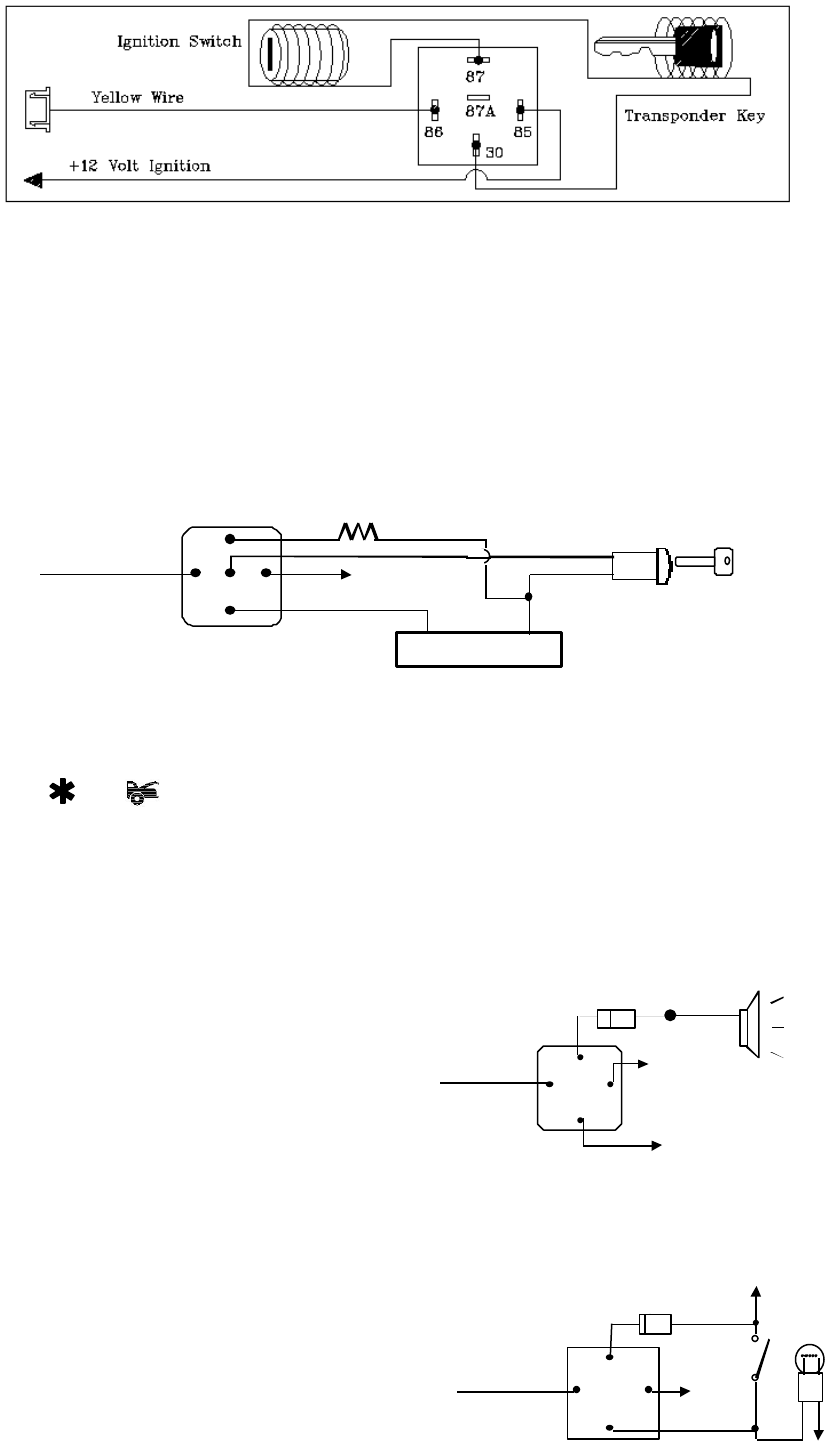
OCT.09, 2002
RST871A 10
GM VATS KEY OVERRIDE:
If the vehicle has the General Motor VATS system installed, you will need to by-pass the system while the
vehicle is operating under the control of the Remote Start Unit. To do this:
1. Measure the resistance of the resistor pellet on the ignition key then select a resistor within 5% of the
key’s value.
2. Locate the pair of VATS wires in the vehicle, usually a pair of thin gauge wires running from the ignition
switch to the VATS control module.
3. Connect the YELLOW wire from Remote Start Unit to TERMINAL #85 of an external relay. Connect
terminal #86 of the relay to a fused +12 volt.
4. Cut (#1) wire (as shown), and connect the ignition switch side of the cut wire to terminal #87a of the relay.
Connect the other side of the (#1) wire to terminal #30.
5. Connect the previously selseced resistor from terminal #87 to the second(#2) wire (as shown).
To + 12 V
Ignition
Switch
YELLOW wire
Matching Resistor
VATS control Module
87a
86
30
87
85
VAT wire (#1)
VAT wire
(#2)
H8/2. Black / Violet wire – (-) 200mA Timer Control Channel 6 Output –
(See Alarm Feature III – 7 Programming) (Factory default setting on momentary grounded)
This wire is built-in user-programmable timer output provides a ground through this wire. Press the
transmitter and button at the same time. You may program the built-in timer to send a ground
signal for any time interval between 1 second and 2 minutes. For instance, this timer output may be used
to turn on the headlight with the remote control. Also on certain BMW, Mercedes Benz, Jaguar and
Volkswagen cars, you can use this unique timed output to allow remote closure of all power window and
sunroof without the need for an external module!
H8/3 Brown / White wire – (-) 200ma Programmable Output (See Alarm Feature III – 4
Programming) –
Horn Output – (Factory default setting)
This wire is prov
ided to use the existing vehicle's
horn as the alarm system's optional's warning
audible device. It's a transistorized low current
output, and should only be connected to the low
current ground output from the vehicle's horn
switch. When the system is trig
gered, the horn
will sound.
85
86
87
87a
30
Brown/White
wire
To horn
+ 12 V
+12V Or Ground
Depending On System
Requirements
FUSE
Factory Security Rearm Signal Output –
This output is programmable. If programmed rearm a factory installed security system. This wire will
supply a pulse whenever the remote start times out or is shut dowm using the transmitter and remote door
locking..
H8/4 White wire – (-) 200ma Dome Light Control Output –
This wire becomes grounded when the dome light
controls circuit active. The current capacity of this
wire is 200mA. This wire can control the operation
of the interior lights. An optional 10 Amps relay
can be used to this system for interior lights
operation.
87a
86
87
30
85
Fuse
White Wire
+12V
Door
Switch
Courtesy
Light
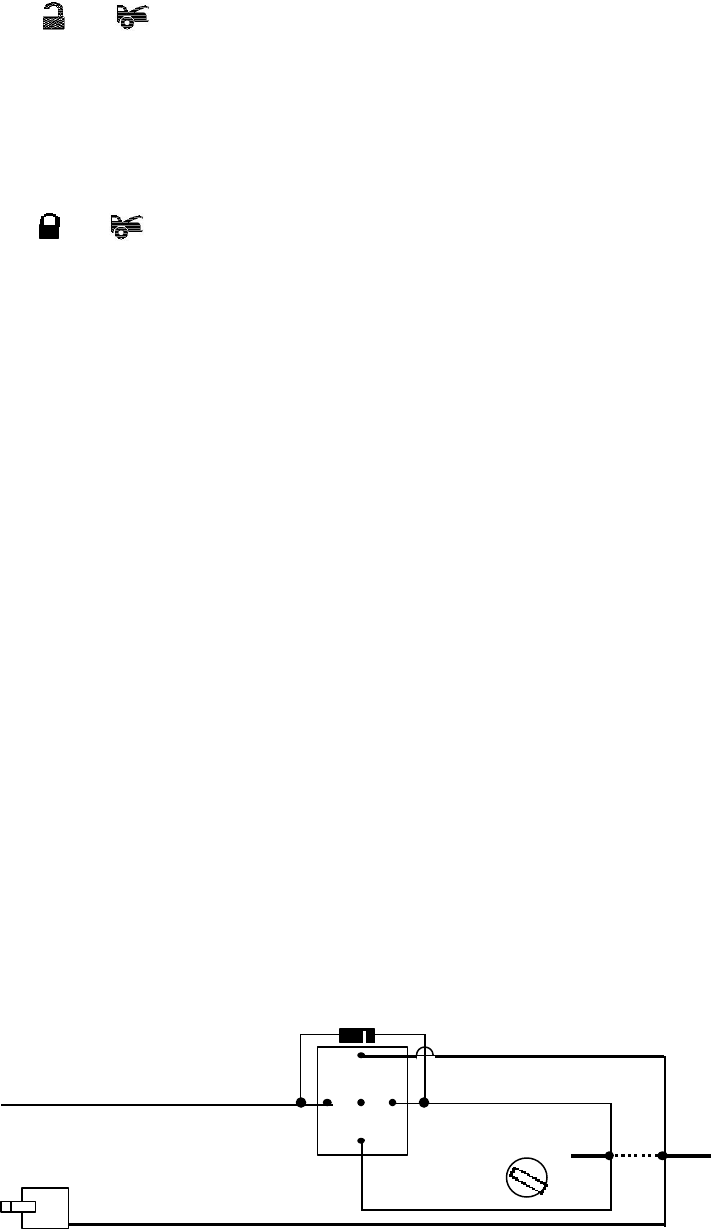
OCT.09, 2002
RST871A 11
a). Upon disarming, the interior lights will remain on for 30 seconds.
b). If the vehicle is violated, the interior light will flash for the same duration as the siren.
H8/5. Black / Red wire – (-) 200mA Timer Control Channel 5 Output –
(See Alarm Feature III – 6 Programming) (Factory default setting on momentary grounded)
This wire is built-in user-programmable timer output provides a ground through this wire. Press the
transmitter and button at the same time. You may program the built-in timer to send a ground
signal for any time interval between 1 second and 2 minutes. For instance, this timer output may be used
to turn on the headlight with the remote control. Also on certain BMW, Mercedes Benz, Jaguar and
Volkswagen cars, you can use this unique timed output to allow remote closure of all power window and
sunroof without the need for an external module!
H8/6 Black / Green wire – (-) 200mA Timer Control Channel 4 / Key Sensor Output –
Channel 4 Output (See Alarm Feature III – 5 Programming) (Factory default setting on momentary grounded)
This wire is built-in user-programmable timer output provides a ground through this wire. Press the
transmitter and button at the same time. You may program the built-in timer to send a ground
signal for any time interval between 1 second and 2 minutes. For instance, this timer output may be used
to turn on the headlight with the remote control. Also on certain BMW, Mercedes Benz, Jaguar and
Volkswagen cars, you can use this unique timed output to allow remote closure of all power window and
sunroof without the need for an external module!
Key Sensor By-Pass Output –
This output is for a Key sense wire by-pass that some Chrysler and Toyota vehicles need to activated
remote start. It wire come on when the start is activated and stay on for 20 seconds.
H8/7 Gray wire – (-) 200ma Channel 3 Output –
This will become a 1 second pulse ground by activate channel 3 on transmitter for two seconds, the current
capacity of this wire is 200 mA. This feature allows you to remote control trunk release or other electric
device.
H8/8 Pink wire – (-) 200ma Programmable Output (See Alarm Feature III – 2 Programming) –
2 Steps Unlock Output – (Factory default setting)
The 2 steps unlock feature will work for the most fully electronic door lock circuit. The vehicle must have an
electronic door lock switch (not the lock knob or key switch), which locks and unlocks all of vehicle's doors.
When wired for this feature, press the disarm (or unlock) button one time will disarm the alarm and unlock
the driver's door only. If, press disarm (or unlock) button two times within 3 seconds, the alarm will disarm
and all doors will unlock.
Factory Security Disarm Signal Output –
This wire is designed to disarm a factory installed security system. This wire sends a negative (-) 1
seconds pulse upon a remote start and remote door unlocking. Some factory systems must be disarmed
to allow remote starting. In most cases, this wire may be connected directly to the factory alarm disarm
wire. The correct wire will show nagative ground when the key is used to unlock the doors or trunk. This
wire is usually found in the kick panel area in the wiring harness coming into the car body from the door.
Start Status (Shock Sensor By-Pass Control) Output–
This wire is designed to by-pass shock sensor module. This wire will supply an output at all times the
remote start is operating plus an additional 3 seconds after the remote start unit turn off.
H8/9 Orange / White wire – 200mA Grounded Output when Disarmed – N.O. Disable –
This wire will become grounded when the alarm is disarmed. The current capacity of this wire is 200mA. It
can be connected to optional Ignition disable relay / ECU disable relay / Fuel Pump disable relay.
87
87a
85
30
86
IN4003 Diode
H8/9: Orange/White wire
from control module
“Start”
“On”
X
Cut
“Acc”
“Off”
H1/4 Yellow wire (Ignition 1 output)
form Heavy Gauge wire harness
To Ignition Coil
H8/10 Orange wire – (-) 200ma Grounded Output When Armed –
This wire will become grounded when the alarm is armed. The current capacity of this wire is 200mA. This
output can control starter disable, when an intrusion is detected and the system is triggered. The vehicles
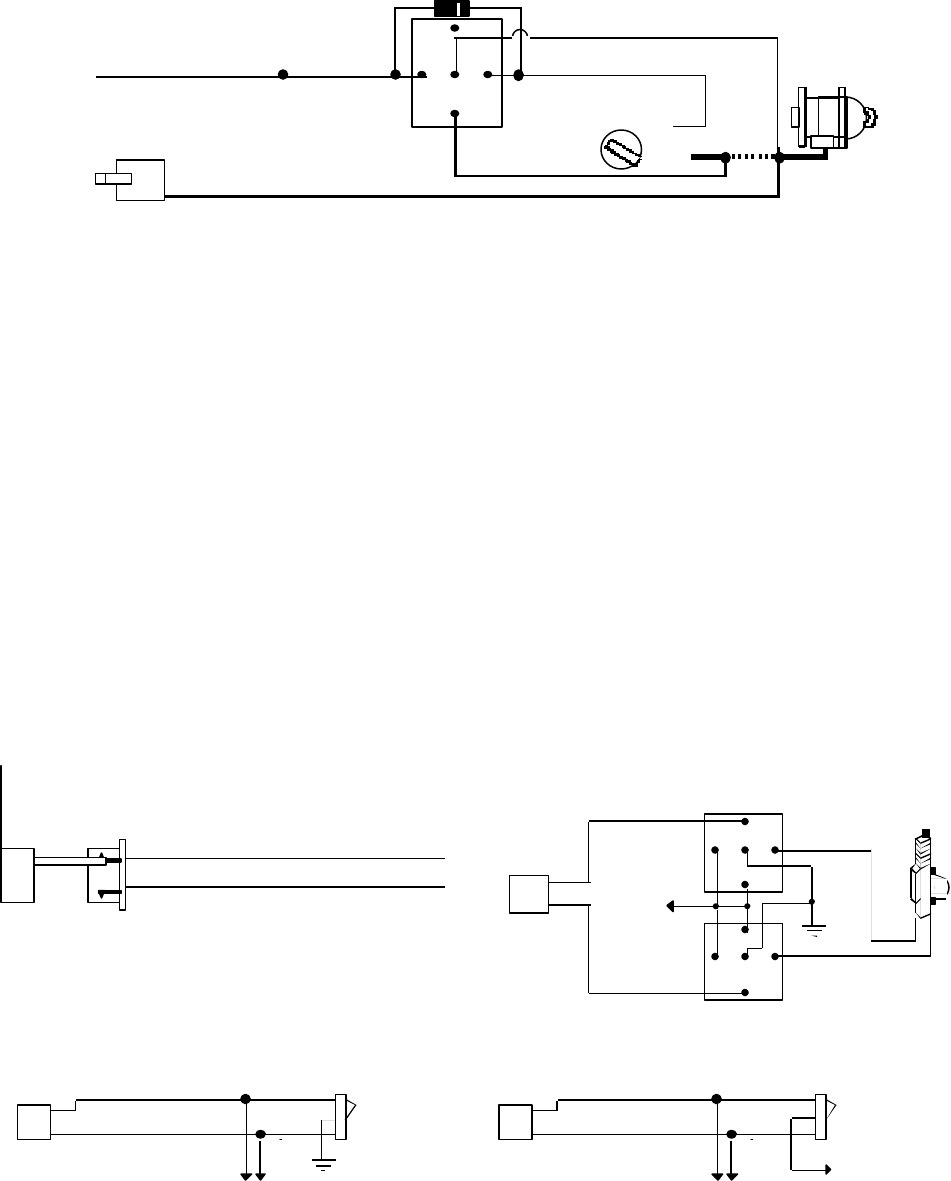
OCT.09, 2002
RST871A 12
prevent from any unauthorized starting.
87
87a
85
30
86
IN4003 Diode
H8/10: ORANGE wire
from control module
“Start”
“On”
White wire
X
Cut
Red wire
Orange wire
“Acc”
“Off”
Starter
H1/1 VIOLET wire (Starter output)
form Heavy Gauge wire harness
Yellow wire to
Ignition Switch
H9. 3 PIN GREEN CONNECTOR FOR OPTIONAL TEMPERATURE SENSOR.
(See Start Feuture I – 7 Programming.)
The optional Temperature Sensor can be add on. You can monitor, through the LCD screen, the present
indoor temperature of the passenger compartment before cooling or heating your vehicle.
It also can be programmed to automatically start the vehicle engine whenever the temperature inside the
vehicle reaches or drops below the preprogrammed temperature level. The system will monitor the air
temperature every 3 hour and will only start the engine during extreme cold temperatures.
H10. 2 PIN BLUE CONNECTOR FOR THE VALET SWITCH:
Select a mounting location for the switch that is easily accessible to the driver of the vehicle. The switch
does not have to be concealed, however, concealing the switch is always recommended, as this provides an
even higher level of security to the vehicle. Mount the valet switch in a hidden but accessible location. Route
the valet switch wires to the control module.
H11. 2 PIN WHITE CONNECTOR FOR THE LED STATUS INDICATOR:
The led indicator status should be mounted in a highly visible area such as top of the dashboard, on top of
the shifter console or on dashboard face. Leave at least 6mm space behind the mounting location for LED
housing. Once a suitable location is chosen, drill a 6mm hole. Run the LED wires through the hole then
press the 2 pin LED housing into the place. Route the LED wires to the control module.
H6. 3 PIN DOOR LOCK CONNECTOR:
Blue Wire
Green Wire ( - ) Lock Pulse
( + ) Unlock Pulse
( - ) Unlock Pulse
(+) Lock Pulse
I
INSTALL NEW DOOR LOCK MOTOR
Blue Wire
Green Wire
+12V
30
86
87a
85
87
30
86
87a
85
87
3 Pin
Plug To
Alarm
NEGATIVE TRIGGER DOOR LOCK SYSTE
Blue Wire Door Unlock
Green Wire Door Lock
Locking
Master
Switch
To Exiting
Door Lock Relay
POSITIVE TRIGGER DOOR LOCK SYSTEM
Blue Wire Door lock
Green Wire Door Unlock
Locking
Master
Switch
To Exiting
Door Lock Relay
+ 12V
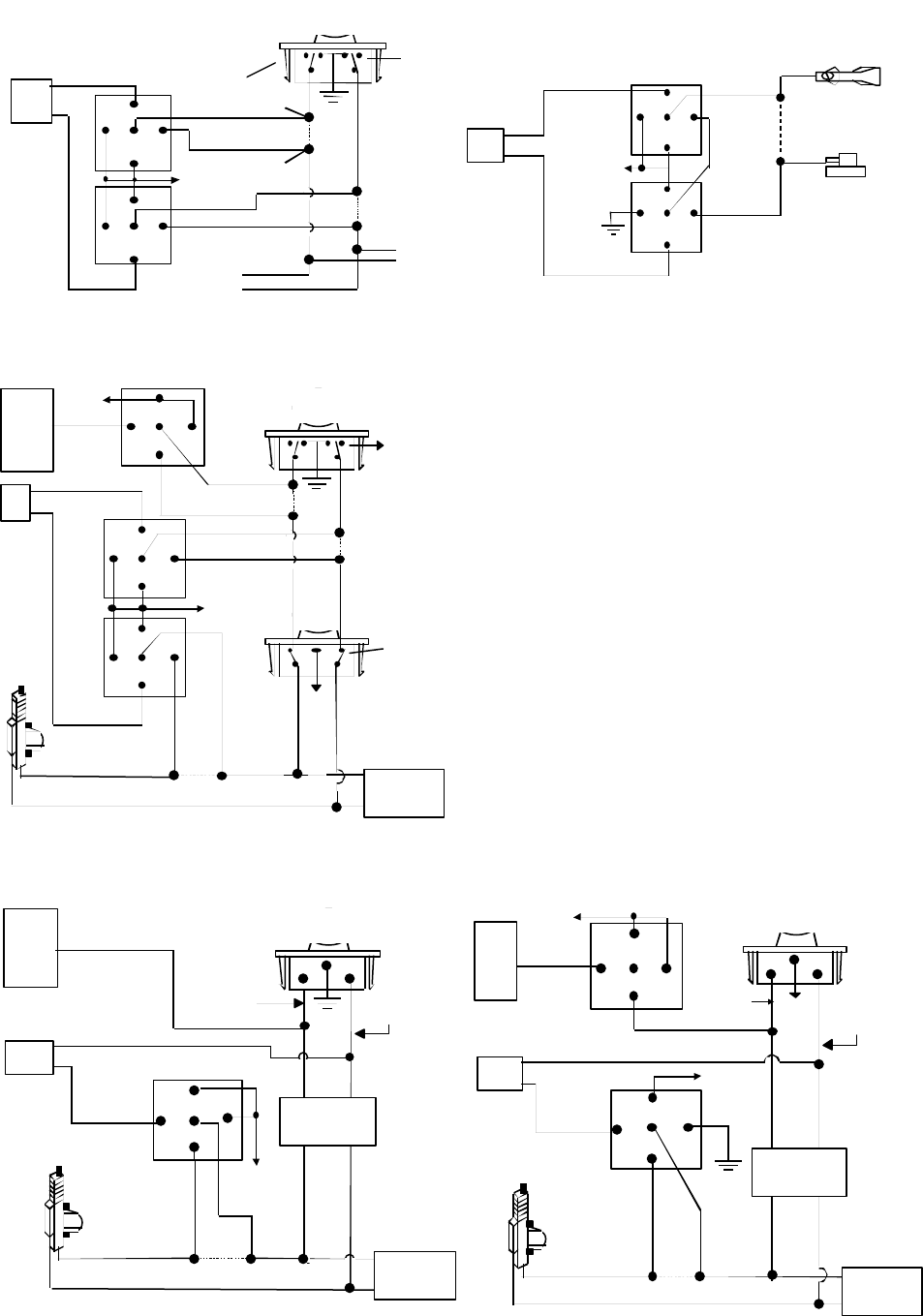
OCT.09, 2002
RST871A 13
+12V
Master Door
Lock Switch
X
X
Splice
Splice
Cut the Existing
Lock Wire
To Door
Lock
Motor
To Slave Door
Lock switches
Cut the Existing
Unlock Wire
3 Pin Plug
To Alarm
5-WIRE ALTERNATING DOOR LOCK
30
86
87a
85
87
30
86
87a
85
87
+12V
Green Wire
Blue Wire
VACUUM OPERATED CENTROL LOCKING
Green Wire
Blue Wire
+12V
XCut
Compressor
Door Switch
30
86
87a
85
87
30
86
87a
85
87
3 Pin
Plug To
Alarm
2 STEP DOOR UNLOCK WIRE CONNECTION FOR
5 WIRE ALTERNATING DOOR LOCKS
+12V
Cut the Existing
Lock Wire
Cut Existing Unlock Wire
X
Cut the Unlock Wire
Lock
Unlock
OEM Door Master Lock
OEM Slave
Door Lock
Switch
+12V
LockUnlock
To All Other
Door Lock
Motors
H8/8:
10-Pin
Plug
From
Alarm
Pink Wire
x
X
Blue Wire
OEM Driver’s
Door Lock Motor
+ 12V
+ 12V
85
86
87
87A
30
30
87
85
87A
86
30
87
85
87A
86
Green Wire
H6:
3 Pin
Plug
To
Alarm
VACUUM OPERATED DOOR LOCKING SYSTEM:
TYPICAL OF MERCEDES BENZ AND AUDI.
Locate the wire under the driver's kick panel. Use the
voltmeter connecting to ground, verify that you have the
correct wire with the doors unlocked, the voltmeter will
receive "12 volts". Lock the doors and the voltmeter will
read "0 volt". Move the alligator clip to +12V and the
voltmeter will receive "12 volts". Cut this wire and make
connections. Be sure to program door lock timer to
3.5 seconds.(See Alarn Feature II – 1 Programming.)
2 STEP DOOR UNLOCK WIRE CONNECTION FOR
GROUND SWITCHED DOOR LOCKS
Cut Existing Unlock Wire
X
LockUnlock
OEM Door Master Lock Switch
To All Other
Door Lock
Motors
Pink Wire
OEM Driver's
Door Lock
Motor
Existing Neg.
Lock Wire
Existing Neg.
Unlock Wire
86
30
85
87
87A
+ 12V
Green Wire
Door Lock
Blue Wire
Door Unlock OEM Door
Lock Relay
H8/8:
10-Pin
Plug
From
Alarm
H6:
3 Pin
Plug
To
Alarm
2 STEP DOOR UNLOCK WIRE CONNECTION FOR
POSITIVE SWITCHED DOOR LOCKS
Cut Existing Unlock Wire
X
LockUnlock
OEM Door Master Lock Switch
To All Other
Door Lock
Motors
Pink Wire
OEM Driver's
Door Lock
Motor
+ 12V
Existing Pos.
Lock Wire
Existing Pos.
Unlock Wire
30
87A
87
86
85
+12V
+ 12V
OEM Door
Lock Relay
86
30
85
87
87A
Green Wire
Door Unlock
Blue Wire Door Lock
H8/8:
10-Pin
Plug
From
Alarm
H6:
3 Pin
Plug
To
Alarm
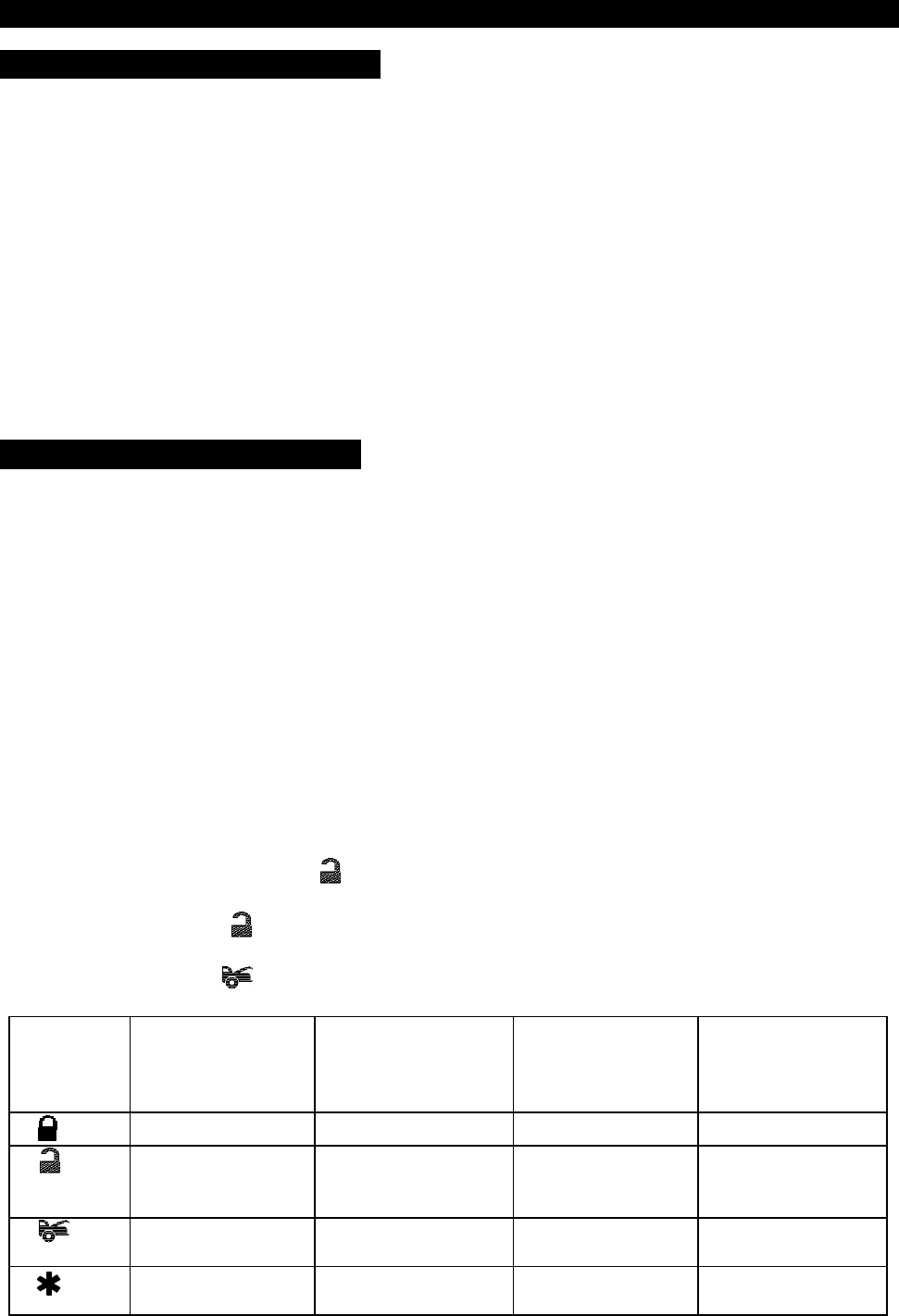
OCT.09, 2002
RST871A 14
ROGRAMMING
A. PROGRAMMING TRANSMITTER:
PROGRAMMING THE REMOTE TRANSMITTER
Note: This mode will only retain the last 4 remote transmitters programmed. If the transmitter memory is
exceeded, the security system will start deleting transmitters from memory in chronological order.
Enter:
1. Turn the Ignition 'switch ‘OFF/ON’ 3 TIMES and stay in ON position. Within 15 seconds.
2. Push the Valet switch 3 times and hold it until a long chirp is hearing then release the valet switch. You are
now in the Transmitter programming mode.
Program:
1. Press button on one of the transmitter until the siren responds with a confirming chirp the first transmitter is
now programmed.
2. Press button on the second transmitter until the siren responds with a confirming chirp, the second
transmitter is now programmed.
3. Apply the same procedure to program 3rd and 4th.
Exit: Turn Ignition to 'OFF' position, or leave it for 15 seconds. A 3 long chirps & 3 parking light flashes to
confirm exit.
B. FEATURES PROGRAMMING:
ALARM FEATURE “I” PRORAMMING:
1. Turn the Ignition 'switch ‘ON/OFF’ 3 TIMES and stay in OFF position.
2. Push the Valet switch 2 times and hold it until one chirp with a long chirp is hearing then release the valet
switch. You are now in the Alarm feature ‘I’ programming mode.
3. Press and release the transmitter button ‘A’ corresponding to the feature ‘A’ you want to program.
a. The siren chirps and LED pause will indicate previously setting.
b. The factory default settings is always [1] LED flash, [1] chirp.
4 Depress the transmitter button ‘A’ a gain to change the feature. Simple keep re-depressing the transmitter
button ‘A’ again until the module advances to your desired setting.
a. In this case, Press button ‘A’ again, the module would advance to [2] LED flash, [2] chirps.
b. Press button ‘A’ again, t he module would advance to [3] LED flash, [3] chirps etc.
5. Depress the transmitter button ‘B’ corresponding to the feature ‘B’ you wants to program.
For example: To program the arming mode form “Active arming” to “Passive Arming without Passive Door
Locking”, After “Arming mode” program, the next program is “Rearm on/off” .……….
1 Turn the Ignition 'switch ‘ON/OFF’ 3 TIMES and stay in OFF position.
2 Push the Valet switch 2 times and hold it until a chirp with a long chirp is hearing then release the valet
switch.
3 Press and release the transmitter button corresponding to the feature ‘Arming mode’ you wants to
program. [1] LED flash, [1] chirp to indicate your are in features “Active Arming”.
4 Depress the transmitter button twice to change the feature. [3] LED flash, [3] chirps to indicate your are
in features “Passive Arming without Passive Door Locking ”.
5 Depress the transmitter button corresponding to the features ”Rearm on/off”’ you want to program……..
Press
Transmitter
Button
One Chirp /
LED one pulse
Factory Default
Setting
Two Chirps /
LED two pulses
Three Chirps /
LED three pulses
Four Chirps /
LED four pulses
1 All chirps on Siren chirp on only Horn chirp on only All chirps off
2 Active arming Passive arming
without passive door
locking
Passive arming with
passive door
locking.
3 Automatic Rearm
on
Automatic Rearm off
4 3 seconds delay
Door Ajar error chirp
30 seconds delay
Door Ajar error chirp.

OCT.09, 2002
RST871A 15
5 + Without this feature With Dome light turns
on after ignition off (45
second door by-pass)
6 + Without Car-jack
mode
Active Car-jack mode Passive Car-jack
mode
7 + Panic with Ignition
off
Panic with Ignition on
& off
Panic with Ignition
on & off. Panic
with No time limit.
Without Panic
function.
Exit: Turn Ignition to 'ON' position, or leave it for 15 seconds. A 3 long chirps & 3 parking light flashes to
confirm exit.
3 / 30 seconds Delay Door Ajar Error Chirp:
This feature controls the error chirp that is generated if the system is armed with the door trigger active. This
useful in a vehicle that has a long dome light delays after the door has been closed. If the system is armed
before the dome light has turned off, the security system will generate the door trigger error chirp. Use this
feature to disable the door open error chirp.
With Dome light turns on after ignition off:
Some vehicles turn on the dome light when ignition key is turned off. After remote start, with alarm on, a false
alarm may occur when the run time elapses and the dome light comes on. To prevent this from happing,
program Alarm Feature I – 5 to “With Dome light turns on after ignition off (45 second door by-pass)”.
ALARM FEATURE “II” PRORAMMING:
1 Turn the Ignition switch ‘ON/OFF’ 3 TIMES and stay in OFF position.
2 Push the Valet switch 4 times and hold it until two chirps with a long chirp is hearing then release the valet
switch. You are now in the Alarm feature ‘II’ programming mode.
3 Press and release the transmitter button ‘A’ corresponding to the feature ‘A’ you want to program.
Press
Transmitter
Button
One Chirp / LED one
pulse
Factory Default
Setting
Two Chirps / LED
two pulses
Three Chirps / LED
three pulses
Four Chirps / LED
four pulses
1 0.8-second Door
lock pulses.
3.5-second Door
lock pulse.
Double pulse unlock
2 Ignition controlled
door locks & unlocks
Ignition controlled
door locks only
Ignition controlled
door unlocks only
Without ignition
controlled door locks
& unlocks
3
Pathway illumination
feature “off”
Parking light turns
“on” for 30 - second
upon an unlock
signal
Parking light turns
“on” for 30 - second
upon an unlock
signal & 10-second
upon a lock signal.
4 H2/5 Brown Wire =
Constant Siren
output
H2/5 Brown Wire =
5-second pulse Siren
output
H2/5 Brown Wire =
Random pulse Siren
output
H2/5 Brown Wire =
Horn Output
Exit: Turn Ignition to 'ON' position, or leave it for 15 seconds. A 3 long chirps & 3 parking light flashes to
confirm exit.
ALARM FEATURE “III” PRORAMMING:
1 Turn the Ignition 'switch ‘ON/OFF’ 3 TIMES and stay in OFF position.
2 Push the Valet switch 6 times and hold it until three chirps with a long chirp is hearing then release the valet
switch. You are now in the Alarm feature ‘III’ programming mode.
3 Press and release the transmitter button ‘A’ corresponding to the feature ‘A’ you want to program.

OCT.09, 2002
RST871A 16
Press
Transmitter
Button
One Chirp /
LED one pulse
Factory Default
Setting
Two Chirps /
LED two pulses
Three Chirps /
LED three pulses
Four Chirps /
LED four pulses
1 Override Without
Password Pin Code
Override With
Password Pin Code
2 H8/8 Pink Wire =
Two step door
unlock output
H8/8 Pink Wire =
Factory Security
Disarm Signal
Output
H8/8 Pink Wire =
Start Status Output
(Shock Sensor
Bypass)
3
4 H8/3 Brown / White
Wire = (-) 200ma
Horn Output
H8/3 Brown / White
Wire = Factory
Security Rearm
Signal Output
H8/6 Black / Green
Wire Channel 4
Output =
Momentary output
H8/6 Black / Green
Wire Channel 4
Output =
Latched output
H8/6 Black / Green
Wire Channel 4
Output =
Latched output and
reset with ignition
“on”
H8/6 Black / Green
Wire Channel 4
Output =
Timer programming
(set to any interval
between 1 second
and 2 minutes.)
5 +
Five Chirps /
LED five pulse
H8/6 Black / Green Wire = Key Sensor By-Pass Output (20second
Ground output during the remote start is activated)
6 + H8/5 Black / Red
Wire Channel 5
Output =
Momentary output
H8/5 Black / Red
Wire Channel 5
Output =
Latched output
H8/5 Black / Red
Wire Channel 5
Output =
Latched output and
reset with ignition
“on”
H8/5 Black / Red
Wire Channel 5
Output =
Timer programming
(set to any interval
between 1 second
and 2 minutes.)
7 + H8/2 Black / Violet
Wire Channel 6
Output =
Momentary output
H8/2 Black / Violet
Wire Channel 6
Output =
Latched output
H8/2 Black / Violet
Wire Channel 6
Output =
Latched output and
reset with ignition
“on”
H8/2 Black / Violet
Wire Channel 6
Output =
Timer programming
(set to any interval
between 1 second
and 2 minutes.)
Exit: Turn Ignition to 'ON' position, or leave it for 15 seconds. A 3 long chirps & 3 parking light flashes to
confirm exit.
Channel 4 (5 / 6) Timer Control Output Programming.
Enter:
1. Turn the Ignition 'switch ‘ON/OFF’ 3 TIMES and stay in O FF position.
2. Push the Valet switch 6 times and hold it until three chirps with a long chirp is hearing then release the valet
switch. You are now in the Alarm feature ‘III’ programming mode.
Timer Program:
1-a. Press and release the transmitter + button 4 times, [4] LED flash, [4] siren/horn chirp to indicate
your are in features “Channel 4 Timer Programming mode”.
1-b. Press and release the transmitter + button 4 times, [4] LED flash, [4] siren/horn chirp to indicate
your are in features “Channel 5 Timer Programming mode”.
1-c. Press and release the transmitter + button 4 times, [4] LED flash, [4] siren/horn chirp to indicate
your are in features “Channel 6 Timer Programming mode”.

OCT.09, 2002
RST871A 17
2. Press and hold the valet switch, the timer will immediately start.
3. When the desired interval has passed, release the valet switch. 1 long chirp for confirmation.
(Set to any interval between 1 second and 2 minutes)
Note 1:
If your built-in timer controls window/sunroof closure in your car DO NOT change the timer setting! This requires
installer-only programming. Changing the value will adversely effect operation and may cause damage.
Note 2:
Momentary output = The momentary output selection will output a negative signal from the Channel 4 (5/6)
output immediately when the channel 4 (5/6) button is pressed and will continue until the button is release.
Latched output = The latched output selection will output a negative signal as soon as the Channel 4 (5/6)
button is pressed and will continue until the button is pressed again.
Latched output / reset with ignition = The latched / reset with ignition output selection operates just like the
latched output but will reset or stop when the ignition is turned on.
Key Sensor By-Pass Output = The 20 seconds setting is for a Key sense wire by-pass that some Chrysler
and Toyota vehicles need to activated remote start. It wire come on when the start is activated and stay on for
20 seconds.
Password Pin Code Setup:
Enter:
1. Turn the Ignition 'switch ‘ON/OFF’ 3 times and stay in OFF position.
2. Push the Valet switch 6 times and hold it until three chirps with a long chirp is hearing then release the valet
switch. You are now in the Alarm feature ‘III’ programming mode. You can program or delete the password
pin code as below:
Program:
1. Press and release the transmitter button twice, [2] LED flash, [2] siren/horn chirp to indicate your are in
features “Password Pin Code Programming mode”.
2. Within 5 seconds, begin to enter your chosen first 9ths digit by pressing and releasing the valet Switch from
1 – 9 times.
3. Within 15 seconds of the last entered 9ths digit, turn the Ignition switch to “ON” posi tion.
4. Within 15 seconds, enter your chosen second 9ths digit by pressing and releasing the valet Switch from 1 –
9 times.
5. Finish by turning the ignition switch to “OFF” position.
If the new password code was accepted, the unit would report back the newly entered code, by flashing the
LED, first indicating the first digit code has been memorized, pause and then the second digit code. The unit
will report the new code three times with a one-second’s pause between each code.
Note: If 15 seconds of inactivity expire, or if the ignition switch is turned “ON” for more then 5 seconds during of
above steps, the unit will revert back to the last successfully stored code. A [3] long chirps to confirm exit. Will
revert back to the last successfully stored code
Delete Password Pin Code / Override Without Password Pin Code (Factory default setting):
Within 15 seconds, press and hold the transmitter button for 3 seconds. A one long chirps to confirm
Deleted the Password Pin Code.
Example: To program the Password Code 92, you would;
Enter:
1. Turn the Ignition 'switch ‘ON/OFF’ 3 times and stay in OFF position.
2. Push the Valet switch 6 times and hold it until three chirps with a long chirp is hearing then release the valet
switch. You are now in the Alarm feature ‘III’ programming mode.
Program:
1. Press and release the transmitter button once, [2] LED flash, [2] siren/horn chirp to indicate your are in
features “Password pin code programming mode”.
2. Within 5 seconds, press and release the valet Switch 9 times.
3. Within 15 seconds of the last entered 9ths digit, Turn the Ignition Switch to “ON” position.
4. Within 15 seconds press the valet Switch twice.
5. Turn the Ignition Switch to “OFF’ position.
You will note the LED flashing nine times, pause and then flash two times, pause. This pattern will be repeated
three times indicating the new code (92) has been accepted and stored in memory.
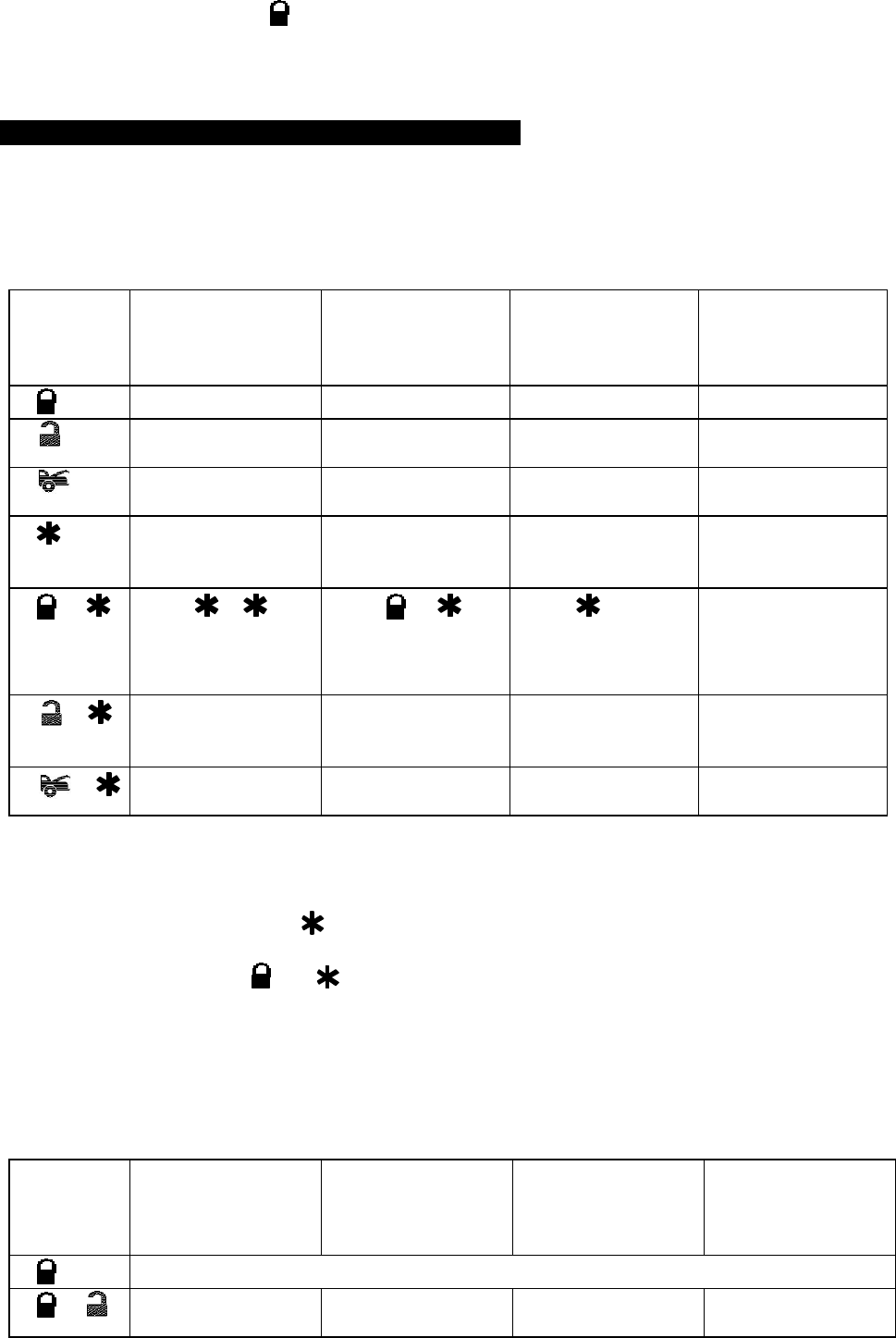
OCT.09, 2002
RST871A 18
Exit: Press any button (except button) of the transmitter to exit the password pin set up mode. A 3 long
chirps & 3 parking light flashes to confirm exit.
REMOTE START FEATURE PROGRAM MODE.
START FEATURE “I” PRORAMMING:
1. Turn the Ignition 'switch ‘ON/OFF’ 3 TIMES and stay in OFF position.
2. Push the Valet switch 8 times and hold it until four chirps with a long chirp is hearing then release the valet
switch. You are now in the Start feature ‘I’ programming mode.
3. Press and release the transmitter button ‘A’ corresponding to the feature ‘A’ you want to program.
Press
Transmitter
Button
One Chirp /
LED one pulse
Factory Default
Setting
Two Chirps /
LED two pulse
Three Chirps /
LED three pulse
Four Chirps /
LED four pulse
1 10 minutes run time 20 minutes run time 30 minutes run time 5 minutes run time
2 Factory alarm disarm
with channel 3 on
Without this feature
3 Constant parking
light output
Flashing parking
light output
4 Door lock before start Door lock after
shut-down
Door lock before
start and Door lock
after shut-down
Without this feature
5 + Press -
button =
Activate Remote
Start.
Press +
button =
Activate Remote
Start.
Press button =
Activate Remote
Start.
6 + H5/8 White / Blue
Wire =
1 pulse activate
H5/8 White / Blue
Wire =
2 pulse activate
H5/8 White / Blue
Wire =
3 pulse activate
7 +
Temperature-Control
Starting OFF
Temperature-Control
Starting 5 F
Temperature-Control
Starting – 4 F
Temperature-Control
Starting – 22 F
Exit: Turn Ignition to 'ON' position, or leave it for 15 seconds. A 3 long chirps & 3 parking light flashes to
confirm exit.
SAFE START (Child safety mode)
Factory defaults setting to press the button twice to start the vehicle.
Programming this feature to eliminate an accidental remote start, when kids enter this transmitter, it requires:
The user press the transmitter and buttons at the same time to start the vehicle.
START FEATURE “II” PRORAMMING:
1. Turn the Ignition 'switch ‘ON/OFF’ 3 TIMES and stay in OFF position.
2. Push the Valet switch 10 times and hold it until five chirps with a long chirp is hearing then release the valet
switch. You are now in the Start feature ‘II’ programming mode.
3. Press and release the transmitter button ‘A’ corresponding to the feature ‘A’ you want to program.
Press
Transmitter
Button
One Chirp /
LED one pulse
Factory Default
Setting
Two Chirps /
LED two pulse
Three Chirps /
LED three pulse
Four Chirps /
LED four pulse
1 Exit the programming mode. (3 long chirp & 3 parking light flashes to confirm this exit.)
2 + Tachometer
checking type.
Voltage checking
type
Timer checking type
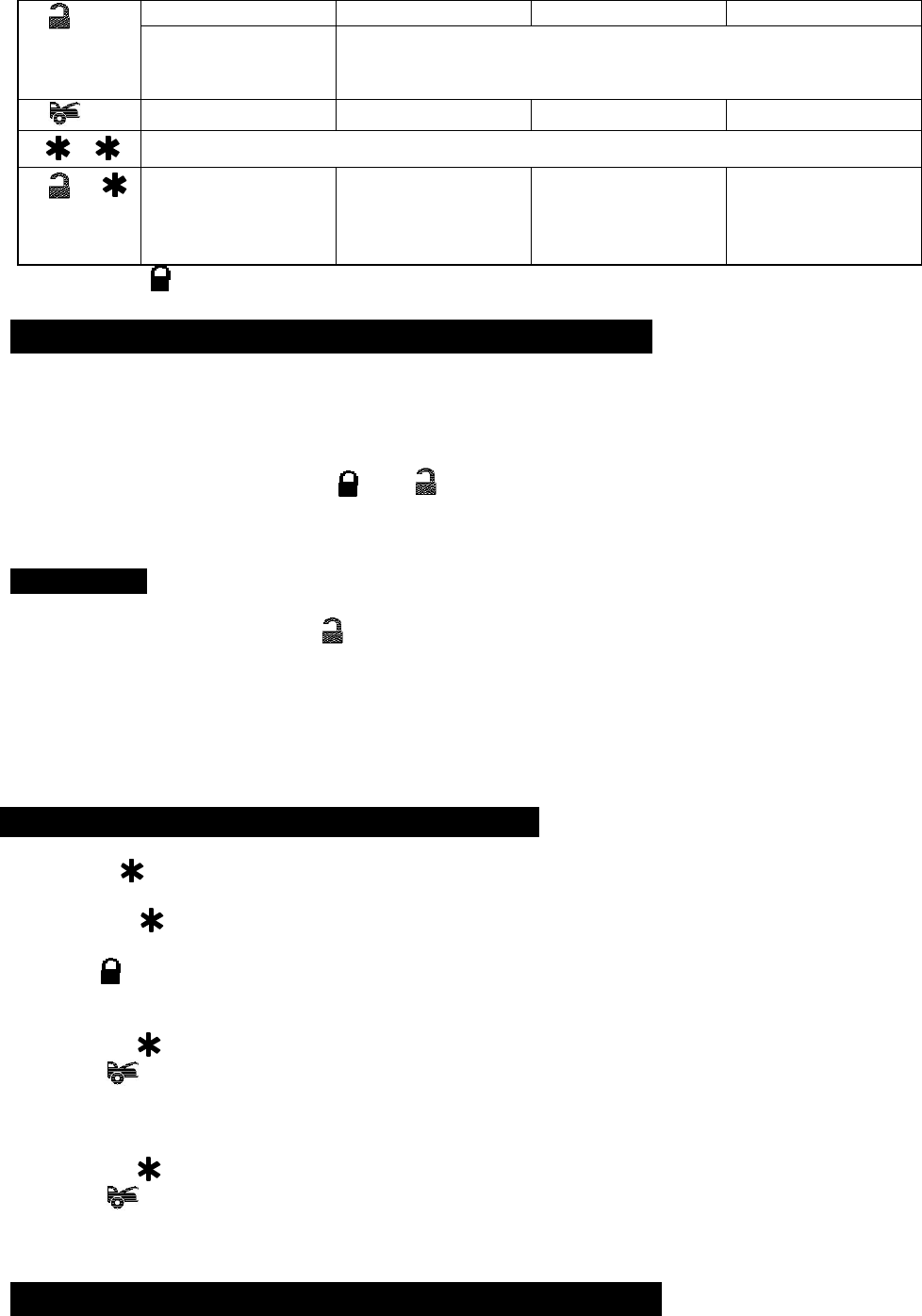
OCT.09, 2002
RST871A 19
RPM learning
3 Start Timer:
0.6-second
0.8-second (2 chirps), 1.0-second (3 chirps), 1.2-second (4 chirps),
1.4-second (5 chirps), 1.6-second (6 chirps), 1.8-second (7 chirps),
2.0-second (8 chirps), 3.0-second (9 chirps), 4.0-second (10 chirps),
4 Hi check level Low check level
5 - Start or Stop the system for TESTING & ADJUSTMENT
6 + “TEST” Mode for
Zone 2 / instant
trigger & Zone 3 /
Door trigger
“TEST” Mode for
Zone 1 & Zone 4 (2
Stage Shock Sensor)
Exit: Press the button on the transmitter. A 3 long chirps & 3 parking light flashes to confirm exit.
TACHOMETER CHECKING TYPE
Enter Start Feature ‘II’ Programming Mode:
1. Turn the Ignition 'switch ‘ON/OFF’ 3 TIMES an d stay in OFF position.
2. Push the Valet switch 10 times and hold it until five chirps with a long chirp is hearing then release the valet
switch. You are now in the Start feature ‘II’ programming mode.
Select “Checking Type”:
3. Press and release the transmitter and button at the same time once to set the “Tachometer
Checking Type”. [1] LED flash, [1] chirp to Confirm this setting.
4. Once you complete step 3, you can program “RPM Learning Mode” as below:
RPM Learning
While the system stay in Start Feature “II” programming mode,
1. Press and release the transmitter button once, [1] LED flash, [1] chirp to indicate your are in features
“RPM Learning mode”.
2. Start the vehicle with the key. (While the engine is running, the parking & LED will flash, If don’t, please
check tachometer White/Red wire connection. (H5/9)
3. Press and hold the valet switch for 2 seconds until a long chirp and the LED light constant for two seconds.
The RPM signal is learned.
4. Once you complete step 3, you can adjust and test “Check Level” as below:
CHECK LEVEL PROGRAMMING: (TEST and ADJUST)
While the system stay in Start Feature “II” programming mode,
1. Press the button twice on the transmitter to start the vehicle.
2. If everything goes well:
a.Press the button twice on the transmitter to stop engine running. You have been completed this
programming successfully.
b.Press button on the transmitter to exit the program mode. There will be 3 long chirps & 3 parking light
flashes for confirmation.
3. If the crank time is too long, (Engine already successfully running, while still cranks):
a. Press the button twice on the transmitter to stop engine running.
Press button on the transmitter to set proper “Check Level ” to Low position. [2] LED flash,
[2] chirps to confirm this setting
b. Repeat the step1 – 4.
4. If the crank time is too short, (Engine not running, while stops cranks):
a. Press the button twice on the transmitter to stop engine running.
Press button on the transmitter to set proper “ Check Level ” to Hi position. [1] LED flash,
[1] chirp to confirm this setting
b. Repeat the step1 – 4.
VOLTAGE CHECKING TYPE
Enter Start Feature ‘II’ Programming Mode:
1. Turn the Ignition 'switch ‘ON/OFF’ 3 TIMES and stay in OFF position.
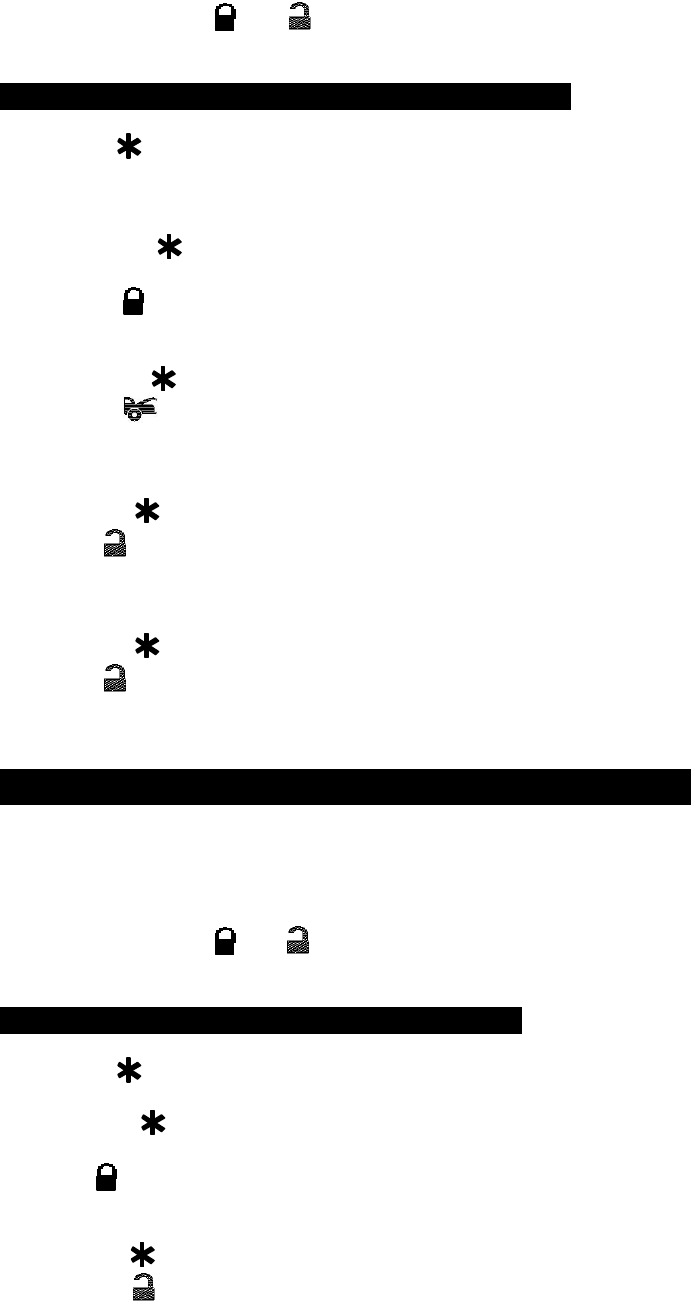
OCT.09, 2002
RST871A 20
2. Push the Valet switch 10 times and hold it until five chirps with a long chirp is hearing then release the valet
switch. You are now in the Start feature ‘II’ programming mode.
Select “Checking Type”:
3. Press the transmitter and
button at the same time to set the “Voltage Checking Type”. [2] LED flash,
[2] chirp to confirm this setting
4. Once you complete step 3, you can adjust and test “Start Timer” as below:
START TIMER PROGRAMMING: (TEST and ADJUST)
While the system stay in Start Feature “II” programming mode,
1. Press the button twice on the transmitter to start the vehicle.
2. If everything goes well:
Wait for 15 seconds:
a. If the engine still running.
I. Press the button twice on the transmitter to stop engine running. You have been completed this
programming successfully.
II. Press button on the transmitter to exit the program mode. There will be 3 long chirps & 3 parking
light flashes for confirmation.
b. If the engine shut down after the vehicle has been started.
I. Press the ' button twice on the transmitter to stop engine running.
II. Press button on the transmitter to set “Check Level” to LOW position. [2] LED flash,
[2] chirp to confirm this setting
III. Repeat the step1 – 2.
3. If the crank time is too long, (Engine already successfully running, while still cranks):
a. Press the button twice on the transmitter to stop engine running.
b. Press button on the transmitter to set proper “Start Timer”. The chirp & LED pause will confirm this
enter. (Decrease “Start Timer” is necessary.)
c. Repeat the step1 – 4.
4. If the crank time is too short, (Engine not running, while stops cranks):
a. Press the button twice on the transmitter to stop engine running.
b. Press button on the transmitter to set proper “Start Timer”. The chirp & LED pause wi ll confirm this
enter. (Increase “Start Timer ” is necessary.)
c. Repeat the step1 – 4.
Timer Checking Type
Enter Start Feature ‘II’ Programming Mode:
1. Turn the Ignition 'switch ‘ON/OFF’ 3 TIMES and stay in OFF position.
2. Push the Valet switch 10 times and hold it until five chirps with a long chirp is hearing then release the valet
switch. You are now in the Start feature ‘II’ programming mode.
Select “Checking Type”:
3. Press the transmitter and button at the same time to set the “Timer Checking Type”. [3] LED flash,
[3] chirp to confirm this setting
4. Once you complete step 3, you can adjust and test “Start Timer” as below:
START TIMER PROGRAMMING: (TEST and ADJUST)
While the system stay in Start Feature “II” programming mode,
1. Press the button twice on the transmitter to start the vehicle.
2. If everything goes well:
a.Press the ' button twice on the transmitter to stop engine running. You have been completed this
programming successfully.
b.Press button on the transmitter to exit the program mode. There will be 3 long chirps & 3 parking light
flashes for confirmation.
3. If the crank time is too long, (Engine already successfully running, while still cranks):
a.Press the button twice on the transmitter to stop engine running.
b.Press the button on the transmitter to set proper “Start Timer”. The chirp & LED pause will confirm this
enter. (Decrease “Start Timer” is necess ary.)
c.Repeat the step1 – 4.
4. If the crank time is too short, (Engine not running, while stops cranks):
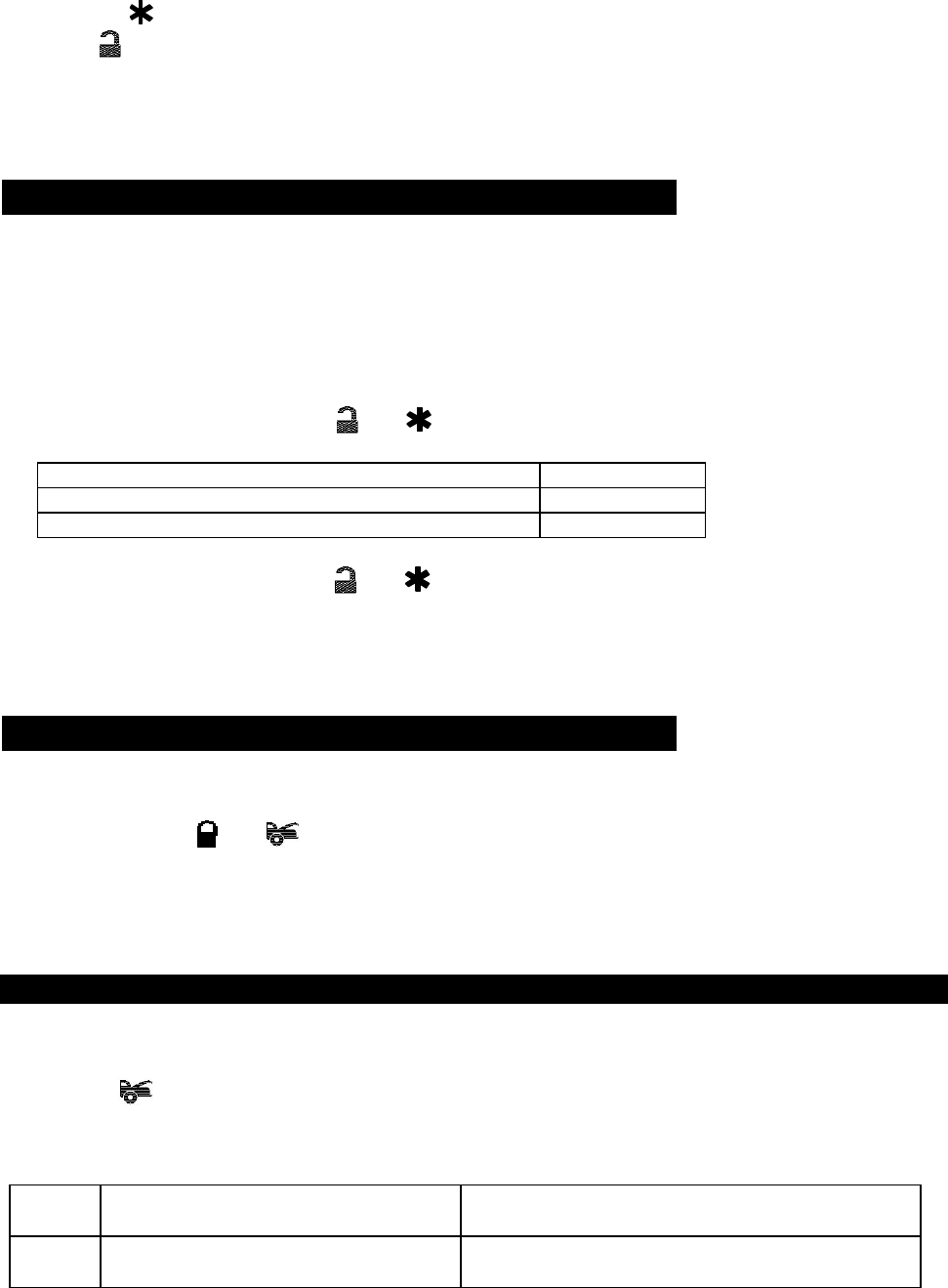
OCT.09, 2002
RST871A 21
a.Press the button twice on the transmitter to stop engine running.
b.Press button on the transmitter to set proper “Start Ti mer”. The chirp & LED pause will confirm this
enter. (Increase “Start Timer ” is necessary.)
c.Repeat the step1 – 4.
TEST MODE
In this test mode, this system can test the Zone 2 (Instant ground trigger), the Zone 3 (Door trigger), and the
Zone 1 & Zone 4 (2 stage shock sensor) sensitivity. The installer can save time to test the 2 stage shock
sensor sensitivity and sensor without using the traditional arming/disarming procedures to test the sensors.
Enter:
1. Turn the Ignition 'switch ‘ON/OFF’ 3 TIMES and s tay in OFF position.
2. Push the Valet switch 10 times and hold it until five chirps with a long chirp is hearing then release the valet
switch. You are now in the Start feature ‘II’ programming mode.
a. Test the Zone 2 / Instant Ground Trigger & Zone 3 / Door Trigger:
Press and release the transmitter and button at the same time once. [1] LED flash, [1] siren/horn
chirp to indicate your are in Zone 2 / instant ground trigger and Zone 3 / Door trigger test mode.
Trigger sensor Siren chirps
Zone 2 / Instant Ground trigger (H5/4 Blue wire) 2
Zone 3 / Door trigger (H5/6 Green or H5/7 Violet wire) 3
b. Test the Zone 1 & Zone 4 / Two Stage Shock Sensor (Connected to H7 4 Pin Plug):
Press and release the transmitter and button at the same time again. [2] LED flash, [2] siren/horn
chirps to indicate your are in the shock sensor (connected to H7 4 pin plug) test mode.
1. Activate the warn-away (first stage of the shock sensor / Zone 1), system will emit a short chirp.
2. Activate the full alarm (second stage of the shock sensor / Zone 4), system will emit a long chirp.
3. Continue to test the shock sensor until reach the proper sensitivity.
RETURN TO FACTORY DEFAULT SETTING:
1. Turn the ignition ON then OFF 3 TIMES and stay in OFF position.
2. Push the Valet switch 12 times and hold it until six chirp with a long chirp is hearing then release the valet
switch. You are now in the “Return To Factory Default Setting” programming mode.
3. Press and hold the and button at the same time on the transmitter for 6 seconds, there will be a
confirmation six chirp with 3 long chirp & 3 parking light flashes to confirm the system “Alarm Feature I & II &
III Programming “ all returns to factory default setting then exit.
Exit: Turn Ignition to 'ON' position, or leave it for 15 seconds. A 3 long chirps & 3 parking light flashes to
confirm exit.
SHUTDOWN DIAGNOSTICS
The unit has the ability to report the cause of the last shutdown of the remote start system.
Enter:
1. Turn the Ignition switch to ‘ON position.
2. Press the button on the transmitter.
3. The LED will now report the last system shutdown by flashing for one minute in the following grouped
patterns:
LED
Flashes
Shutdown Mode
1 (-) Safety Shutdown input (Hood) 1. Close the hood.
2. Check H5/1 White/ Black wire connection.

OCT.09, 2002
RST871A 22
2 (+) Safety Shutdown input (Brake) or
Neutral Safety Switch input fail.
1. Check H5/2 White/ Violet wire connection.
2. Move the Enable Toggle Switch to “ON” position.
(If installed.)
3. Move the gear selector to “Park”/ “NEUTRAL”
position.
4. Check H5/3 Black/White wire connection.
3 No RPM or
Low Voltage.
Tachometer Checking Type:
Check H5/9 White/Red wire connection
Voltage Checking Type:
Program the “CHECK LEVEL” from
“Hi Ch eck Level” to “Low Check Level”
5 Over-rev
6 System timed out
7 Transmitter
8 Tach. Signal has not been learned Re-learning the RPM (Start Feature
II – 2 / 3)
9 The procedure of the Engine start
memorizing for the vehicle with standard
(manual) transmission gear is not
completed.
Check Operation Manual # Remote Start Operation
B section.
TESTING YOUR INSTALLATION:
Caution!! The follow procedure must be performed after the installation of the Remote Start Device. It is the
responsibility of the installing technician to complete these tests. Failure to test the unit in the following manner
may result in personal injury, property damage, or both.
1. Test the BRAKE shutdown circuit: With the vehicle in park (P), start the vehicle using the remote transmitter,
Once the engine is running, press the brake pedal. The vehicle should shut down immediately. If the vehicle
continues to run, check the brake circuit WHITE/ VIOLET wire (H5/2) connection.
2. Test the HOOD PIN shutdown circuit: Start the vehicle using the remote transmitter, Once the engine is
running, pull the hood release and raise the hood. The vehicle should shut down immediately. If the vehicle
continues to run, check the hood pin WHITE/ BLACK wire (H5/1) connection.
3. NEUTRAL START SAFETY TEST:
1. Set the vehicle parking brake.
2. Block the drive wheels to prevent vehicle movement.
3. Sitting in the vehicle, turn the ignition switch to “ON” or “RUN” position. But do not start the engine.
4. Step on the brake pedal and shift the gear selector into “DRIVE” (D).
5. Put your foot over the brake pedal but do not press down on it. Be ready to step on the brake to shut down
the Remote Start Device.
6. Start the vehicle using remote transmitter.
a. If the starter does not engage, the test is complete.
b. If the starter engages, immediately step on the brake pedal to shut down the system, recheck your
VIOLET wire (H1/1 starter output wire) connection. The heavy gauge VIOLET wire must be connected to
the ignition switch side of the Neutral Start Switch. If the vehicle you are working on does not have an
Electrical Neutral Safety Switch, it will be necessary to reconfigure the Remote Starts Wiring to
accommodate this vehicle. The information concerning the Mechanical Neutral Safety Switch provided
below will help you to determine if the vehicle you are working on has this type of safety switch and will
provide alternate wiring methods to accommodate this situation.
MECHANICAL NEUTRAL SAFETY SWITCH CONSIDERATIONS:
Mechanical neutral safety switch configurations differ slightly in that they do not offer the same level of safety
when installing a remote start device. Often when the ignition switch is turned off while the gear selector is in
any position other than park or neutral, the mechanical function will not allow the key to be turned to the start
position or be removed from the ignition cylinder. This configuration prevents mechanical operation while the
vehicle is in gear but offers no consideration for electrical operation. Because of this potential problem, this
installation requires the additional connection of a safety wire from the remote start device to the vehicle
PARK/NEUTRAL ECM input or the vehicle key in sensor. This connection will prevent remote start operation if
the key is left in the ignition switch regardless of the gear selector position.
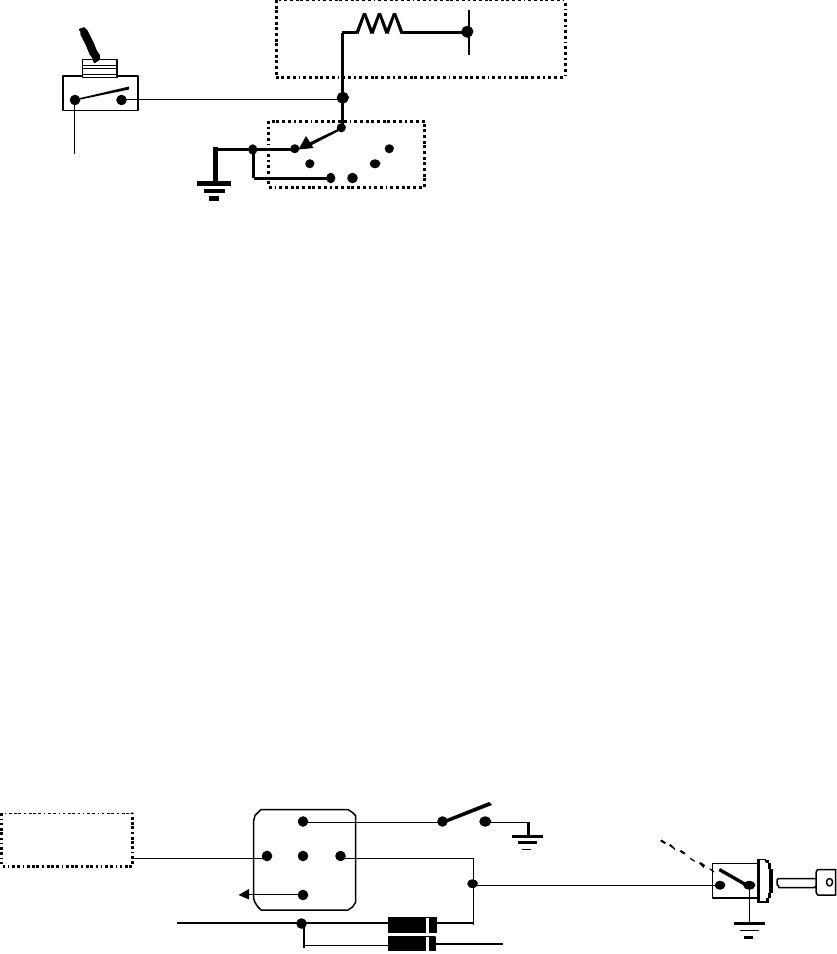
OCT.09, 2002
RST871A 23
PARK/NEUTRAL ECM INPUT:
The Park/Neutral ECM input is the preferred method of installation. This not only maintains the integrity of the
factory circuit, it is also the easiest to install, providing the vehicle you are working on has this ECM input.
The installation required for this application (shown below), indicates in the slight reconfiguration of the control
switch wiring. Shown is a typical GM Park/Neutral ECM input circuit. To connect the Remote Start unit to the
GM Park/Neutral ECM input:
1. Locate the Orange/Black reference wire in the “C2” connector found at the ECM in GM B Body vehicles or,
locate the equivalent reference wire in the vehicle you are installing the Remote Start Unit in.
2. Connect the BLACK/WHITE Neutral Safety Switch wire (H5/3) to this reference wire.
NOTE: If the optional remote starts enable toggle switch is installed, connect the one side the enable switch to
this reference wire and connect the other side of the enable switch to the BLACK/WHITE Neutral Safety Switch
wire (H5/3) of the Remote Start unit.
The reference diagram below shows a typical GM B Body ECM reference wire and how it is to be connected to
the Remote Start Unit.
Ignition
P
1
2
D
N
R
Electronic Control Module (ECM)
Solid State, Do Not Measure
Resistance
To Neutral Safety
Switch Input wire
Black/White (H5/3)
Optional Enable Switch
KEY IN SENSOR CIRCUITS:
If the vehicle you are working on does not have or you cannot locate the ECM reference wire, there are two
alternatives available. Although not preferred, the vehicle Key In Sensor may be reconfigured to allow a margin
of safety and will prevent the vehicle with a Mechanical Neutral Start Switch from starting in gear.
WE ADVISES THAT YOU MAINTAIN THE FACTORY CIRCUIT WHENEVER POSSIBLE. The following two
circuits may be used only if the above circuit is not available.
NOTE: When completing an installation using either of the following key in sensor circuits, if the operator
inserts the ignition key while the vehicle is running under the control of the Remote Start, the vehicle will shut
down. This must be explained to the operator as it is in contrast to the normal operation of a vehicle utilizing an
electrical neutral start switch and is inconsistent with the operators manual.
Additional information concerning Key in Sensor methods 1&2 are listed below and should be reviewed before
considering either alternative.
Method 1 will allow the safety required for the remote start unit and prevent the vehicle from starting while in any
gear other than Park or Neutral while the key is in the ignition cylinder however, if the key is left in the ignition
switch and the door is left opened, the added relay will be energized causing a 150mA drain on the battery.
Method 2 will allow the safety required for the remote start unit and prevent the vehicle from starting while in any
gear other than Park or Neutral while the key is in the ignition cylinder however, the original factory key in
chime module will not alert the owner that the key has been left in the ignition switch. In addition, this may also
effect other warning tones such as the light on reminder.
These situations should be carefully considered before altering the vehicle’s wiring and must be fully explained
to the consumer.
METHOD 1
+ 12 V
Ignition Key In Sensor
Switch Closes with Key
In Ignition Cylinder
Switch
Drivers Door Pin Switch
87a
86
3087
85
Key In
Chime Module
Connected to (-) Negative
Safety Input Wire
White/ Black (H5/1)
To Hood Pin Switch
Safety Shut Down (H5/1)
1N4003
+ 12V
To connect to the key in sensor as shown in method 1:
A. Locate the control wire that connects the drivers door pin switch to the key in sensor switch.
B. Cut this wire and connect the ignition cylinder side to chassis ground.
C. Locate the key in sensor switch wire that connects the chime module to the ignition cylinder.

OCT.09, 2002
RST871A 24
D. Cut this wire and connect the ignition cylinder side to terminal 30 of a P&B VF45F11 or equivalent relay.
E. Connect the cathode (striped) side of a 4003 series diode to this same wire, and connect the (non striped)
side to the negative safely input wire (WHITE/ BLACK) (H5/1) of the Remote Start Unit.
F. Connect terminal 86 of the relay to a fused + 12 volt constant battery source.
G. Connect terminal 87 of the relay to the Chime Module side of the previously cut wire in step D.
H. Connect terminal 85 of the relay to the Drivers Door side of the pin switch wire previously cut in step B.
Note: A second 4003 series diode may be required to maintain the integrity of the hood open, shut down circuit.
If this is the case, it must be installed as shown in the diagram above. The anode (Non Stripped) side must be
connected to the WHITE/ BLACK wire (H5/1) of the Remote Start Unit. The cathode (Striped) side must be
connected to the hood pin switch. If the hood pin switch is also used for an alarm trigger input, be certain to
use the dual diode assembly packaged with the Remote Start Unit as shown in this installation guide.
METHOD 2
Ignition Key In Sensor
Switch Closes with Key
In Ignition Cylinder
Switch
Connected to (-) Negative
Safety Input Wire
White/ Black (H5/1)
To Hood Pin Switch
Safety Shut Down (H5/1)
1N4003
To connect to the key in sensor circuit as shown for method 2:
A. Locate the control wire that connects the drivers door pin switch to the key in sensor switch.
B. Cut this wire and connect the ignition cylinder side to chassis ground.
C. Locate the key in sensor switch wire that connects the chime module to the ignition cylinder.
D. Cut this wire and connect the ignition cylinder side to the Remote Start Negative Safety Shut down wire
WHITE/ BLACK (H5/1), using a 4003 series diode as shown above.
Note: A second 4003 series diode may be required to maintain the integrity of the hood open, shut down circuit.
If this is the case, it must be installed as shown in the diagram above. The anode (Non Striped) side must be
connected to the WHITE/ BLACK wire (H5/1) of the Remote Start Unit. The cathode (Striped) side must be
connected to the hood pin switch. If the hood pin switch is also used for an alarm trigger input, be certain to
use the dual diode assembly packaged with the Remote Start Unit as shown in this installation guide.
AFTER THE CONNECTION OF THE NEUTRAL START SAFETY WIRE AS INDICATED IN ANY OF THE
PREVIUOS ALTERNATE CONFIGURATINS, THIS CIRCUIT MUST BE TESTED FOR OPERATION.
Retest by following the steps outlined in the NEUTRAL START SAFETY TEST shown in this manual.
OCT.09, 2002
RST871 25
This device complies with part 15 of the FCC rules. Operation is subject to the following two conditions/:-
(1) This device may not cause harmful interference
(2) This device must accept any interference received: including interference that may cause undesired
operation.
Note: The manufacturer is not responsible for any radio TV interference caused by unauthorized modification to
this equipment. Such modifications could void the user’s authority to operate the equipment.